Bern – Walking Switzerland’s Capital
This is my final post from a June 2022 tour of Switzerland with Adventures Abroad led by our good friend Victor Romagnoli. Although over nine months have passed since Alison and I took this trip with Victor, I can remember each day of it as if it was last week, the trip was that remarkable. It included a perfect combination of alpine hiking, amazing train rides and city walking tours. In the last post I featured a great day on Mount Rigi which we arrived at by boat from Lucerne followed by a funicular ride up to the top. In this post we’ll visit the Swiss capital city of Bern and spend the day exploring it on foot. Please come along with us.
History of Bern
From Lucerne to Bern it’s a one hour train ride through the Bernese Oberland and by now I have become somewhat complacent with the wonderful Swiss scenery, failing to take any pictures along the way. My bad.
We are met at the station by our local guide Michael Glur and immediately begin the walking tour of Bern which is the Rodney Dangerfield of Swiss cities. Everybody knows about Geneva, Zurich, Lucerne, Lausanne and Basel, but who ever adds Bern to their list of must visit Swiss cities? That’s a shame, because it is a UNESCO World Heritage Site which none of those other cities can claim.
Unlike many Swiss cities Bern has a definitive foundation date. Although there are traces of occupation in the area daring back to Neolithic times, it first became a definitive settlement in 1191 when the regionally powerful Zähringen family chose a site on a hill in a bend of the Aare River to establish a base here. The Zähringen family died out a century later, after which Bern became an Imperial Free City. In the early 1300’s it joined an alliance of other Swiss cantons and together they managed to defeat a much larger invading Fribourg army that had the backing of the Hapsburgs and Burgundians. It joined the Swiss federation in 1353 and from this point on in its history for hundreds of years Bern remained relatively unscathed by external events. It became the aggressor and managed to extend its influence over the surrounding area we now call the Bernese Oberland. That ended in 1799 when Napoleonic forces occupied the area for a number of years, but with no great damage to city proper. In 1848 Bern was chosen as the seat of the Swiss government, one of the smallest capital cities in Europe. Today it has a population of just over 130,000 with an urbanized area about three times that big.
So what has Bern got that qualifies it for World Heritage Site status that other Swiss cities don’t. Here’s what UNESCO has to say about the city it refers to as Berne:
Berne developed along the lines of exceptionally coherent planning principles. The medieval establishment of Berne, reflecting the slow conquest of the site by urban extensions from the 12th to the 14th century, makes Berne an impressive example of the High Middle Ages with regard to the foundation of a city, figuring in the European arena among the most significant of urban planning creations. The features of Berne were modified to reflect the modern era: in the 16th century, picturesque fountains were introduced to the city and restoration work was carried out on the towers and walls and the cathedral was completed. In the 17th century, many patrician houses were built of sandy limestone, and towards the end of the 18th century, a large part of the constructed zones underwent transformation. However, this continual modernization, right through to the present day, was carried out observing the need to conserve the medieval urban structure of the city. The Old City of Berne is a unique example demonstrating a constant renewal of the built substance while respecting the original urban planning concept, and presenting a variation of the late Baroque on a theme of High Middle Ages.
In other words, Bern has done a world class job of preserving its various architectural embodiments from early Medieval through to late Baroque in a manner that has created a one of a kind European city. Of particular note are its many fountains and arcades.
The name of the city is generally associated with the word ‘bear’ although there is no consensus that this was the original meaning. But we will see a lot of bear references as we tour the city.
With this background let’s join Michael and Victor and start exploring Bern.
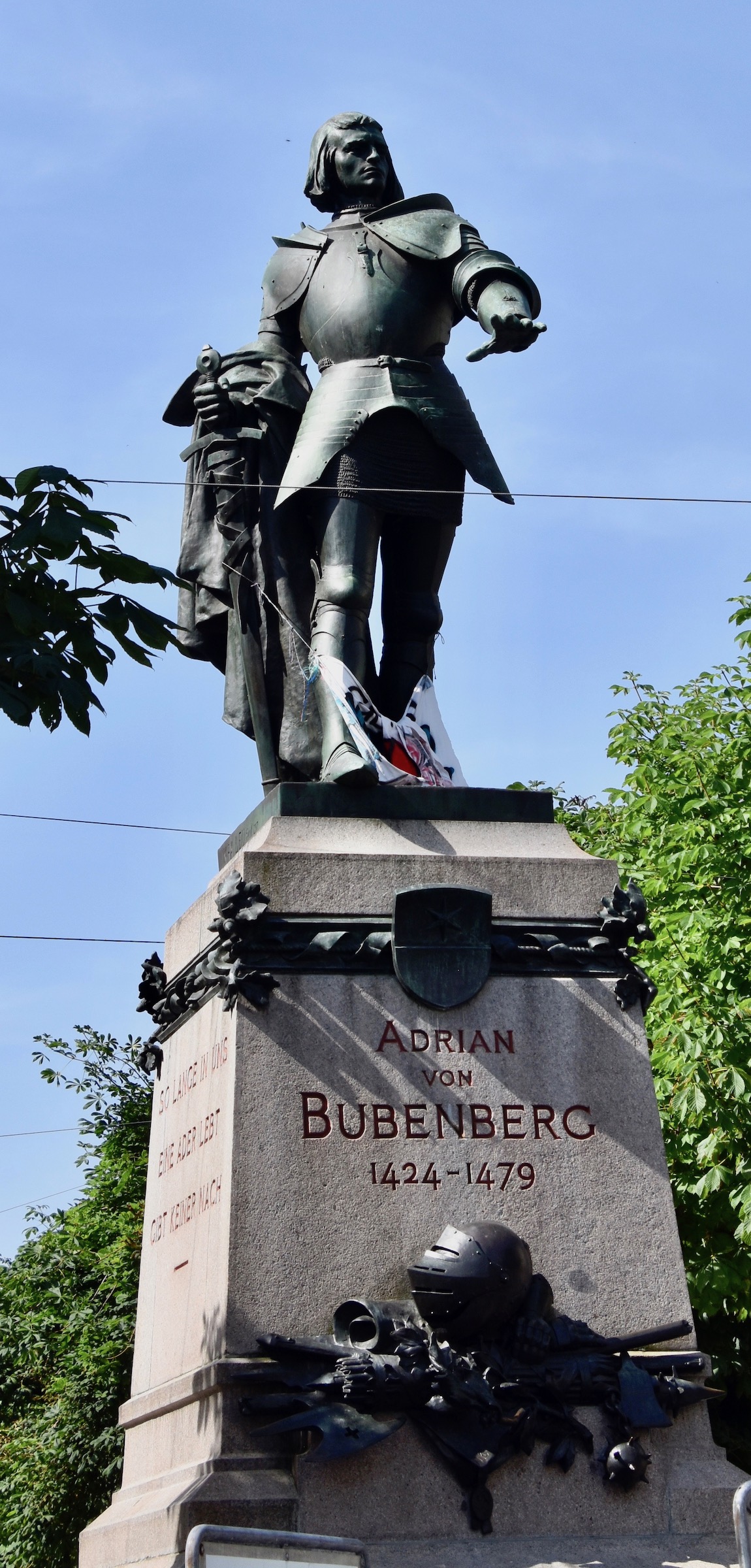
Our first stop is just outside the station where we come across this imposing statue of Adrian von Bubenberg who had a very interesting history that some might think says a lot about the Swiss. He was originally famous for a number of knightly exploits including the successful repulsion of a Burgundian invasion in 1476. However, by the time he died 1479 he was broke and owed a lot of money. In something that seems peculiarly Swiss, he was posthumously banned from the city in 1481 because of this. Apparently penury trumped heroism in the eyes of the city’s burgers. Von Bubenberg got the last laugh when several influential works of romantic literature made him the embodiment of valour and civic service. In 1887 Bern changed its mind about him and erected this statue in his honour.
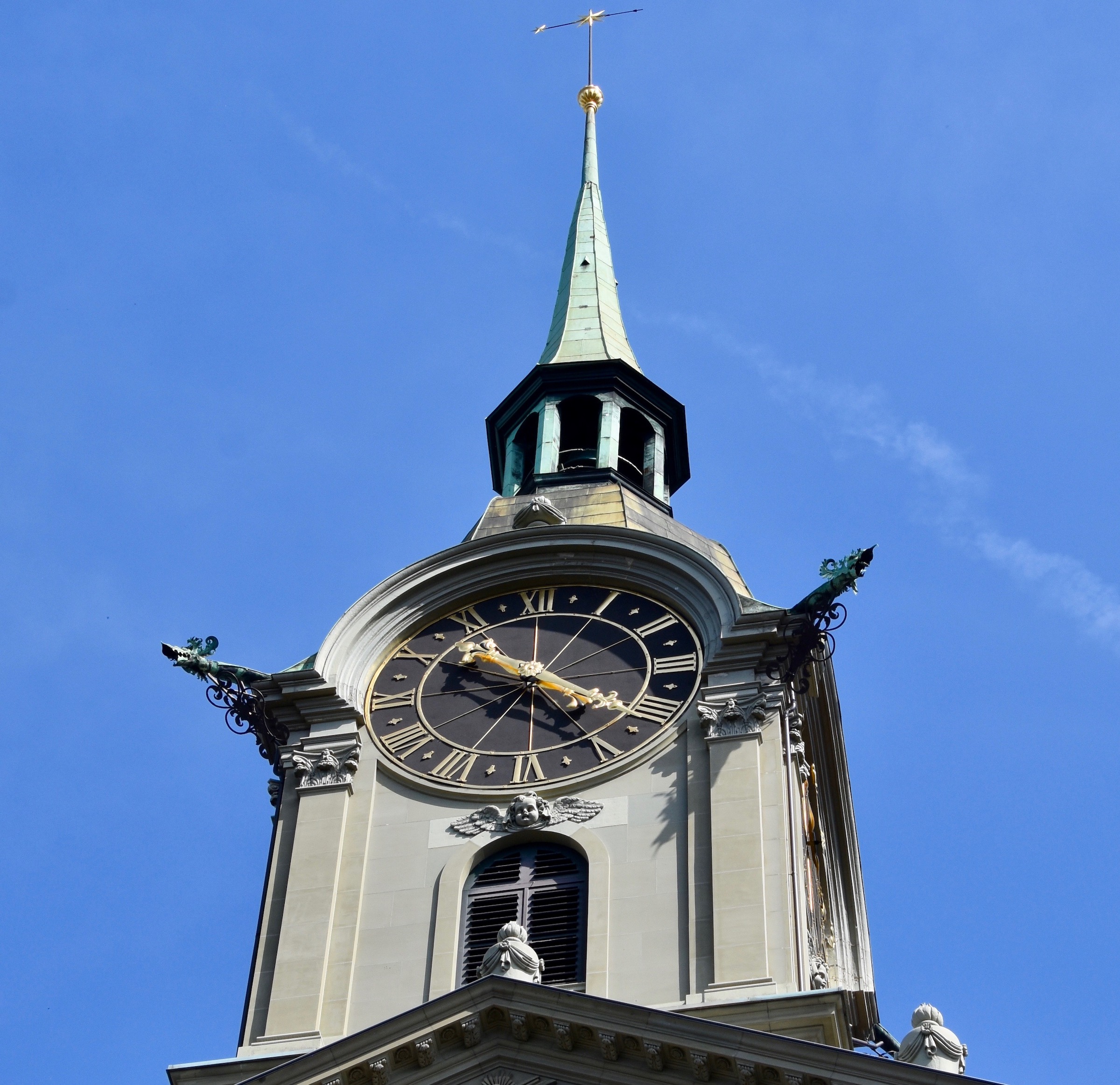
Heading toward the city centre we pass the Heiliggeispital or Church of the Holy Spirit which doubled as a church and hospital for the destitute from the 13th to the 18th centuries. It is in keeping with Swiss church spires in having a clock that is accurate to the minute.
We reach our first of Bern’s many famous fountains, the Pfeiferbrunnen or Piper Fountain which looks very fresh, but is actually 475 years old. 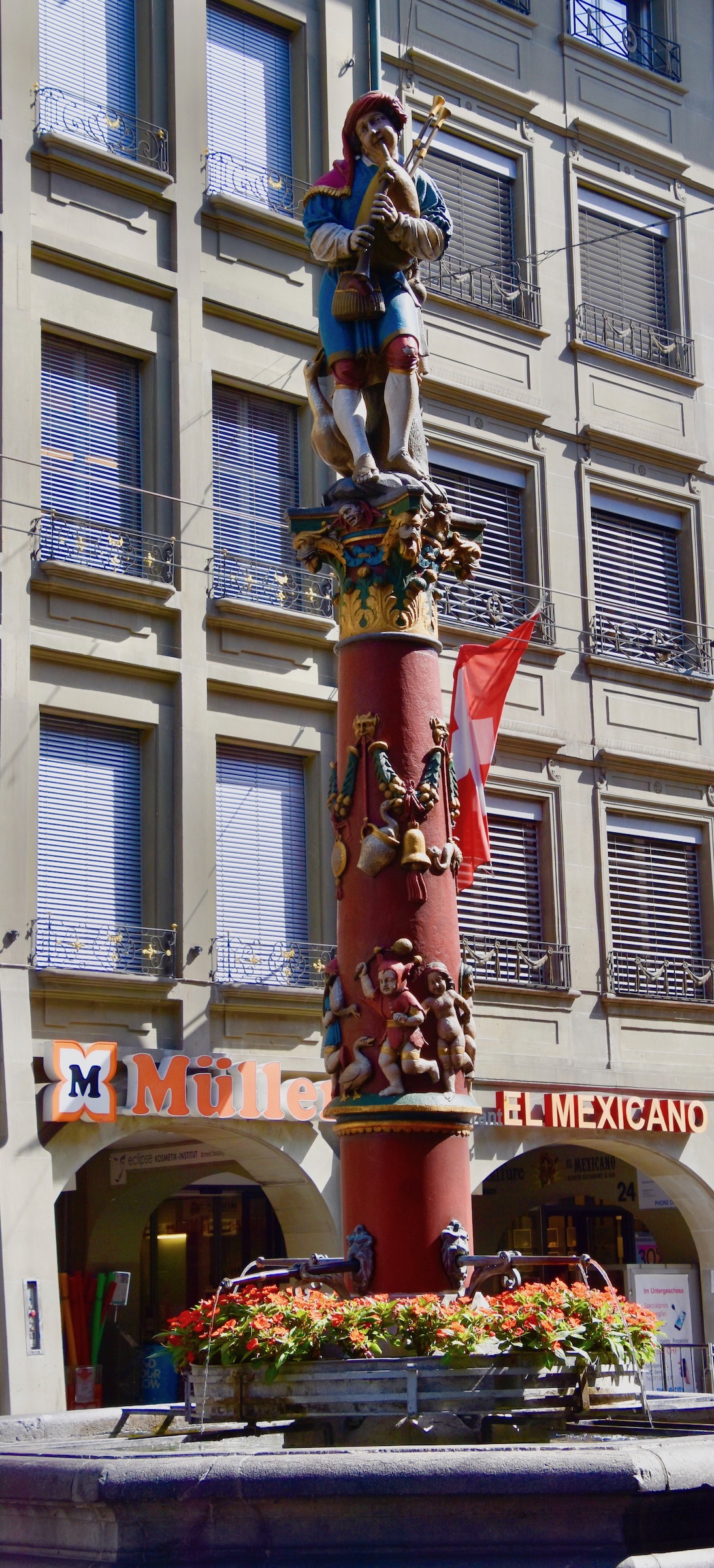 The Piper Fountain
The Piper Fountain
It was created by sculptor Hans Gieng based upon this drawing of a bagpiper by Albrecht Durer.
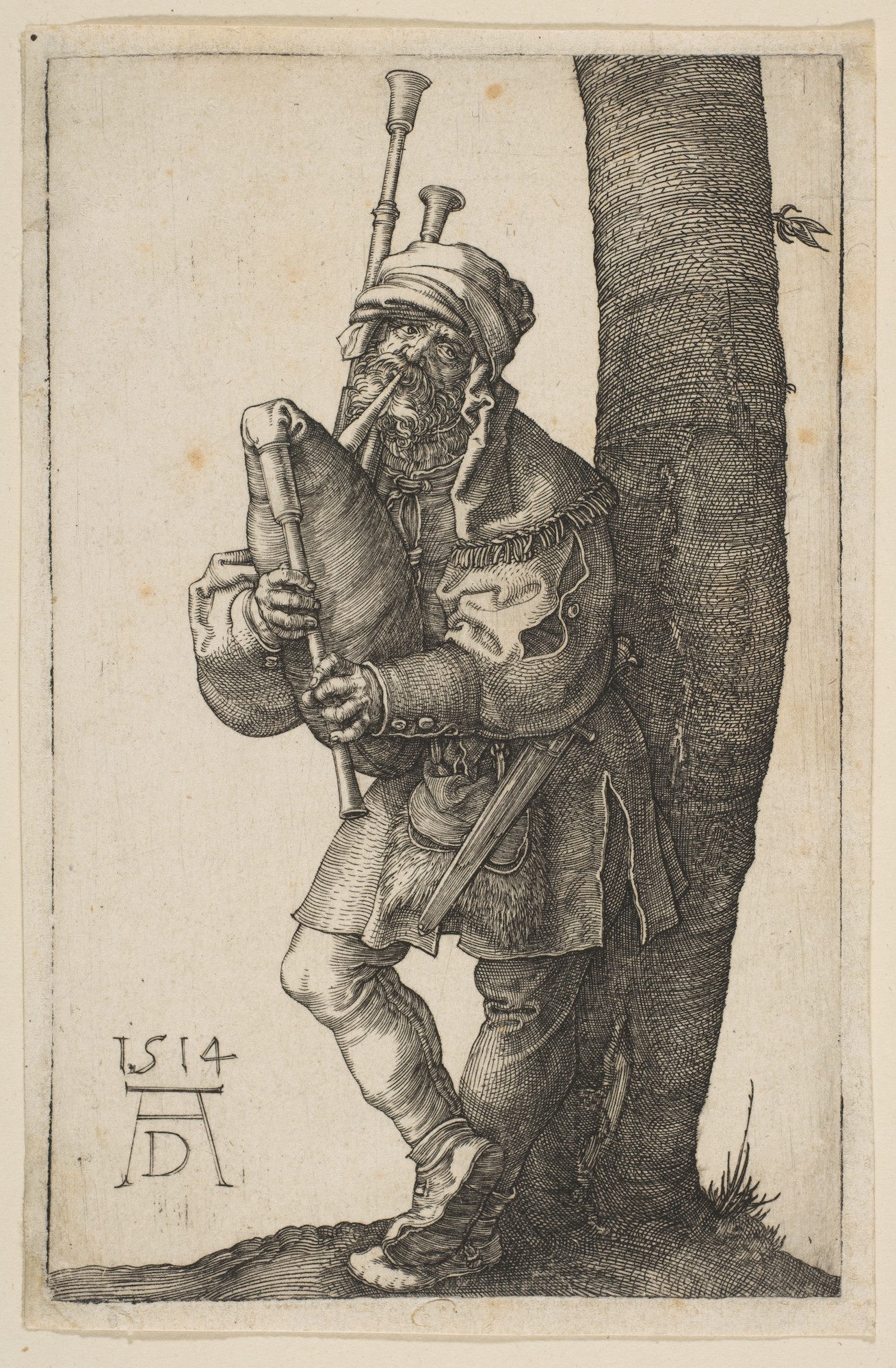
As I have noted in earlier posts, the water coming out of these Swiss fountains is perfectly drinkable and many people rely upon them to replenish their water bottles on a daily basis.
We next pass through a small flower market on the way to the Swiss capitol building.
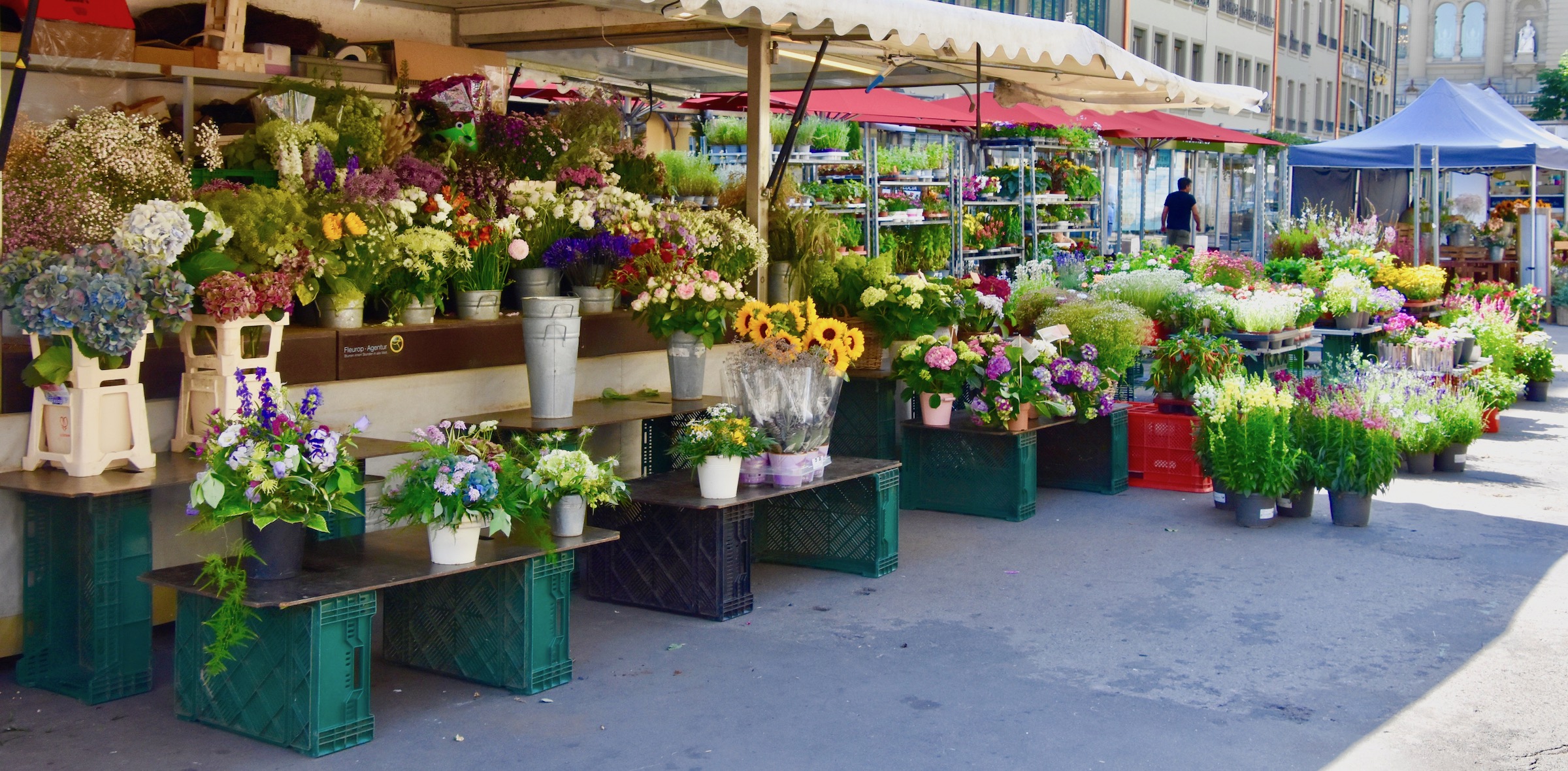
Bern became the capital of Switzerland in 1848, but the capitol building dates from 1902. BTW in case you think I am mixing up the words capital and capitol, I’m not. Somewhat inexplicably to me a nation’s seat of government is the capital, but the actual building where the government meets is the capitol. Go figure. No wonder people say English is a very difficult language to master.
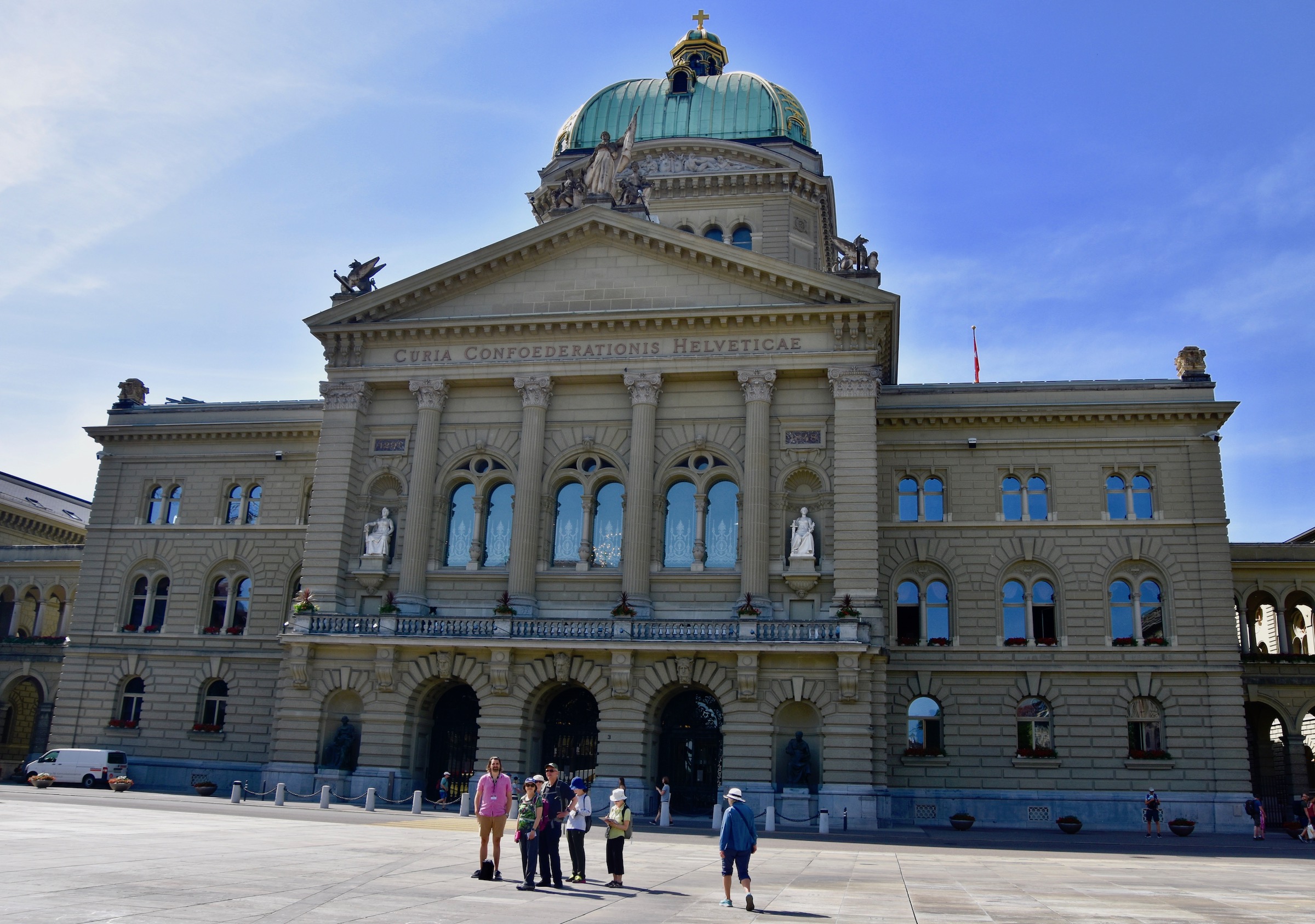
As capitol buildings go I would rate this as a B. The Neo-Renaissance style with a few Neo-Classical columns thrown in for good measure doesn’t quite do it for me. But the green dome and statue of a man with a bear cub makes for a nice juxtaposition.
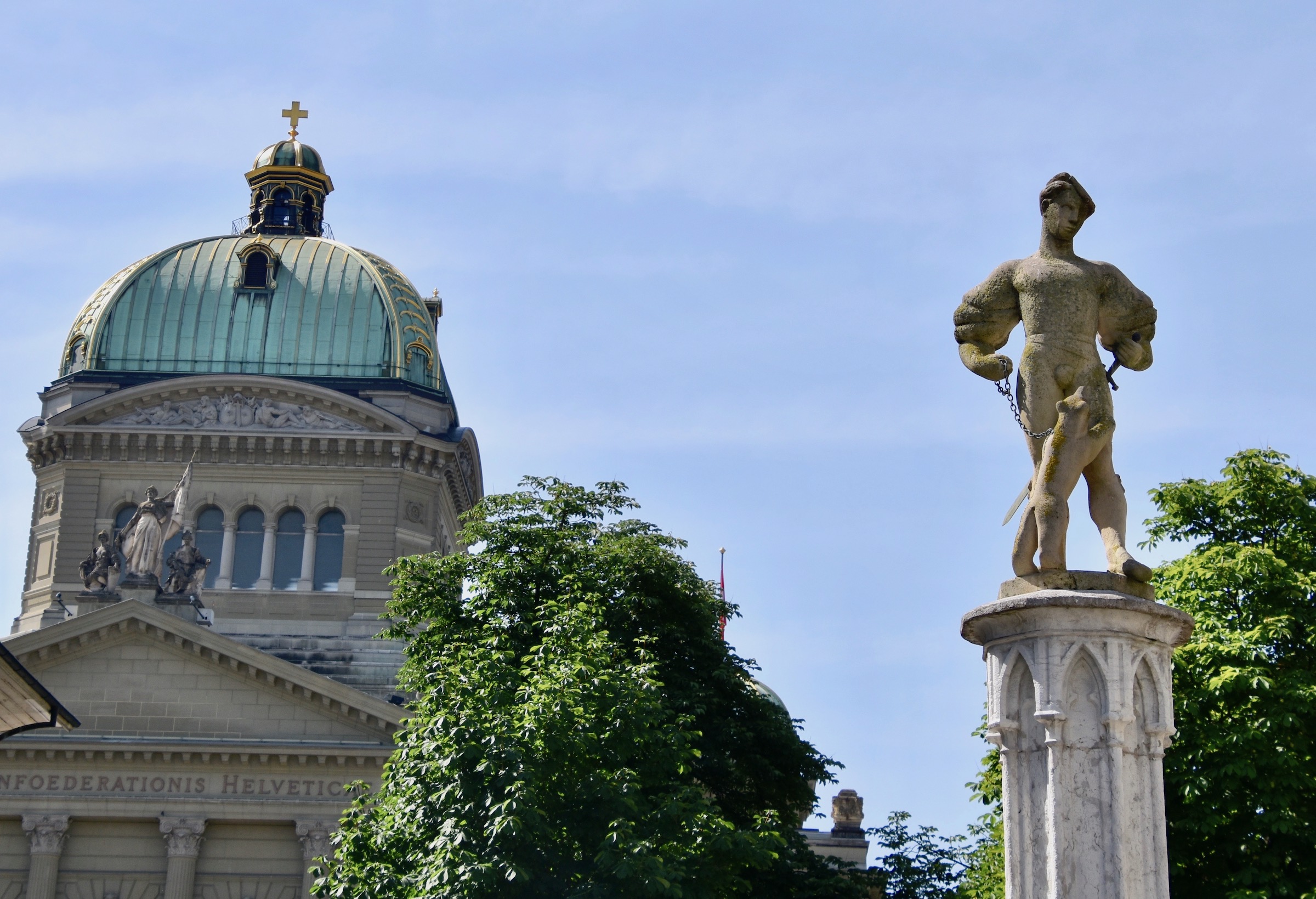
There are a number of interesting faces sculpted over the three archways leading into the capitol building and I found this one particularly intriguing. I am unable to find any information as to why there is an angry looking man with pig’s ears adorning the capitol building in Bern. However, it did strike me as a close resemblance to Bilbo Baggins as portrayed by the late great Ian Holm in The Hobbit.
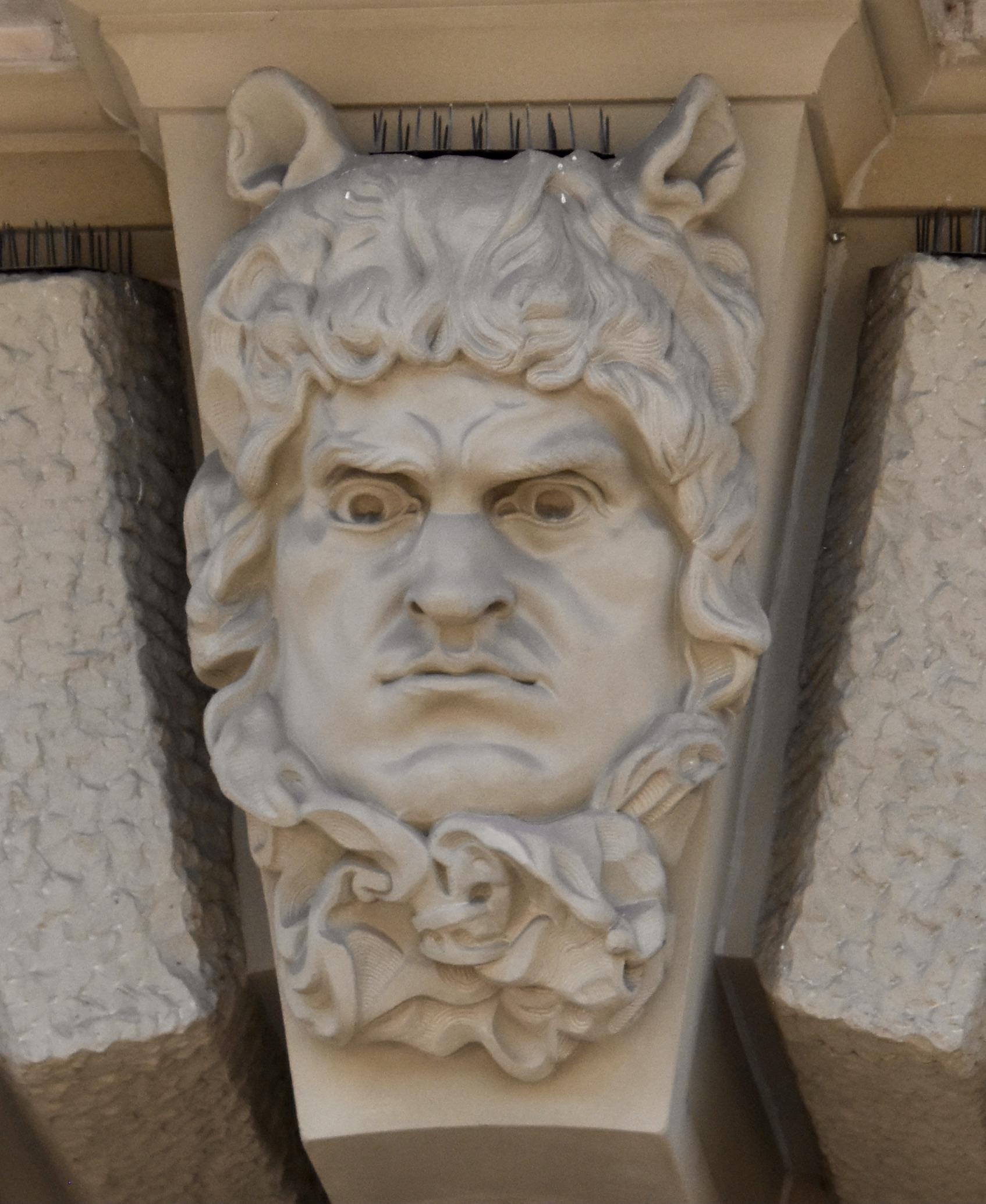
We were now at the highest point in Bern and Michael led us to a belvedere overlooking the Aare River far below.
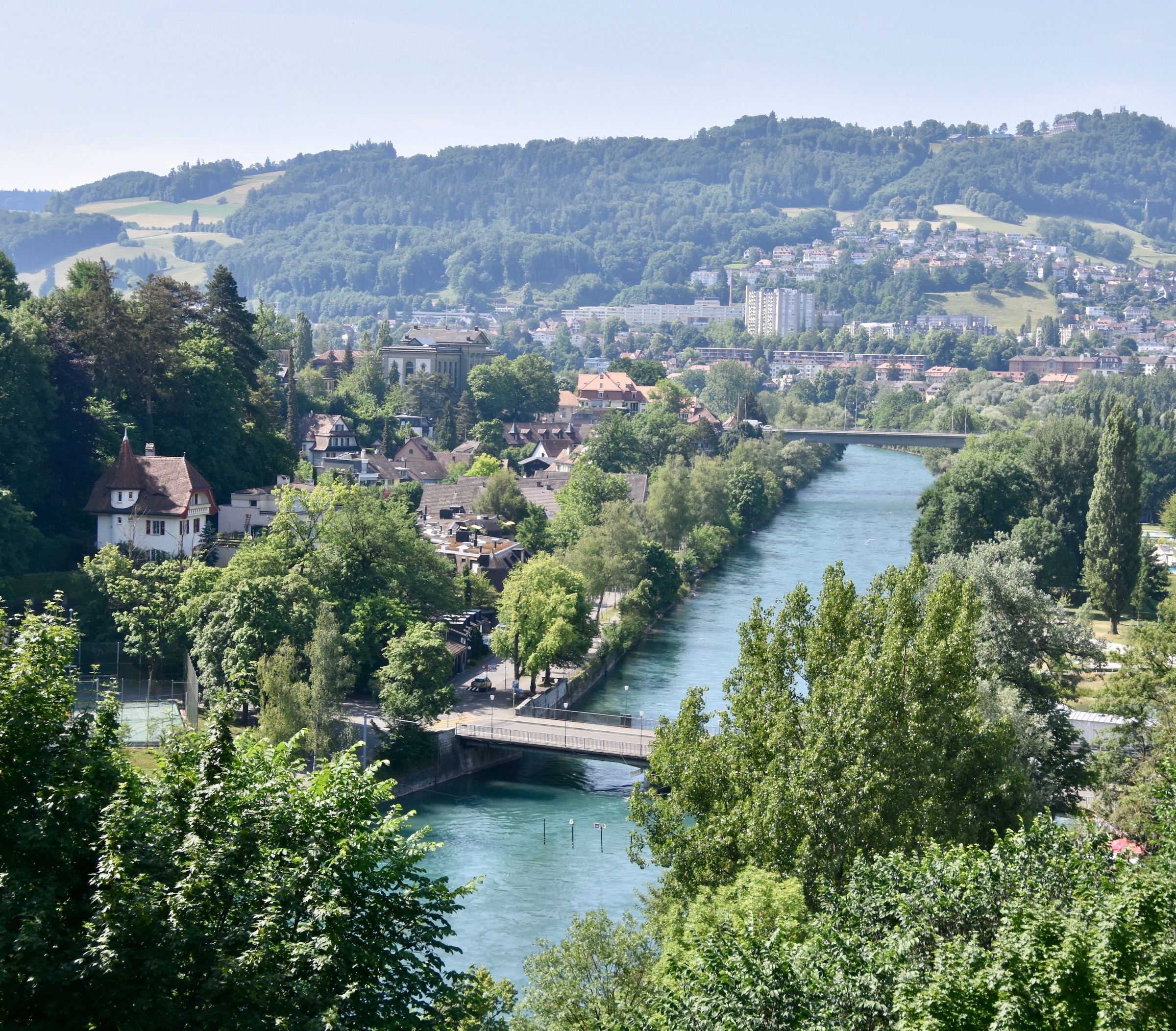
The most famous tourist attraction in Bern is not the capitol building, the cathedral or the fountains, but rather a clock tower. But this is no ordinary clock tower. The Zytglogge has been a part of the city since 1405, but its fame dates from the installation of the astrolabium and the musical display in 1530. We’ve all seen videos, usually from Germany, of elaborate devices that play out a story on a clock tower every hour. Well the one in Bern is arguably the most elaborate of them all with a story that involves a crowing rooster, dancing bears, a court jester, Chronos the god of time and finally a golden man striking a golden bell.
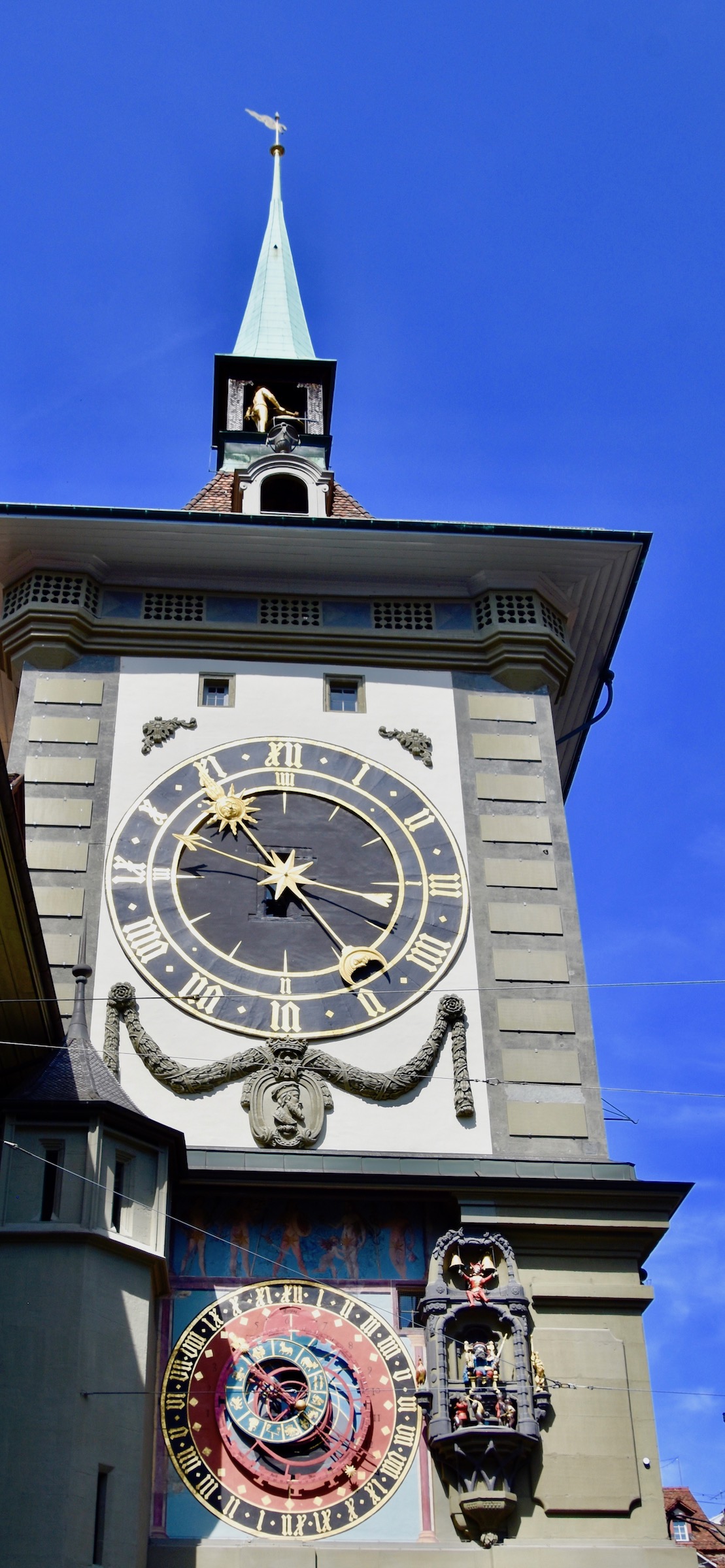
This is a photo of the Zytglogge with the golden man on top with the clock beneath him and below that the astrolabium on the left and the mechanical device to the right. As you can see it’s ten to eleven and a considerable crowd is gathering for the show that will take place on the hour.
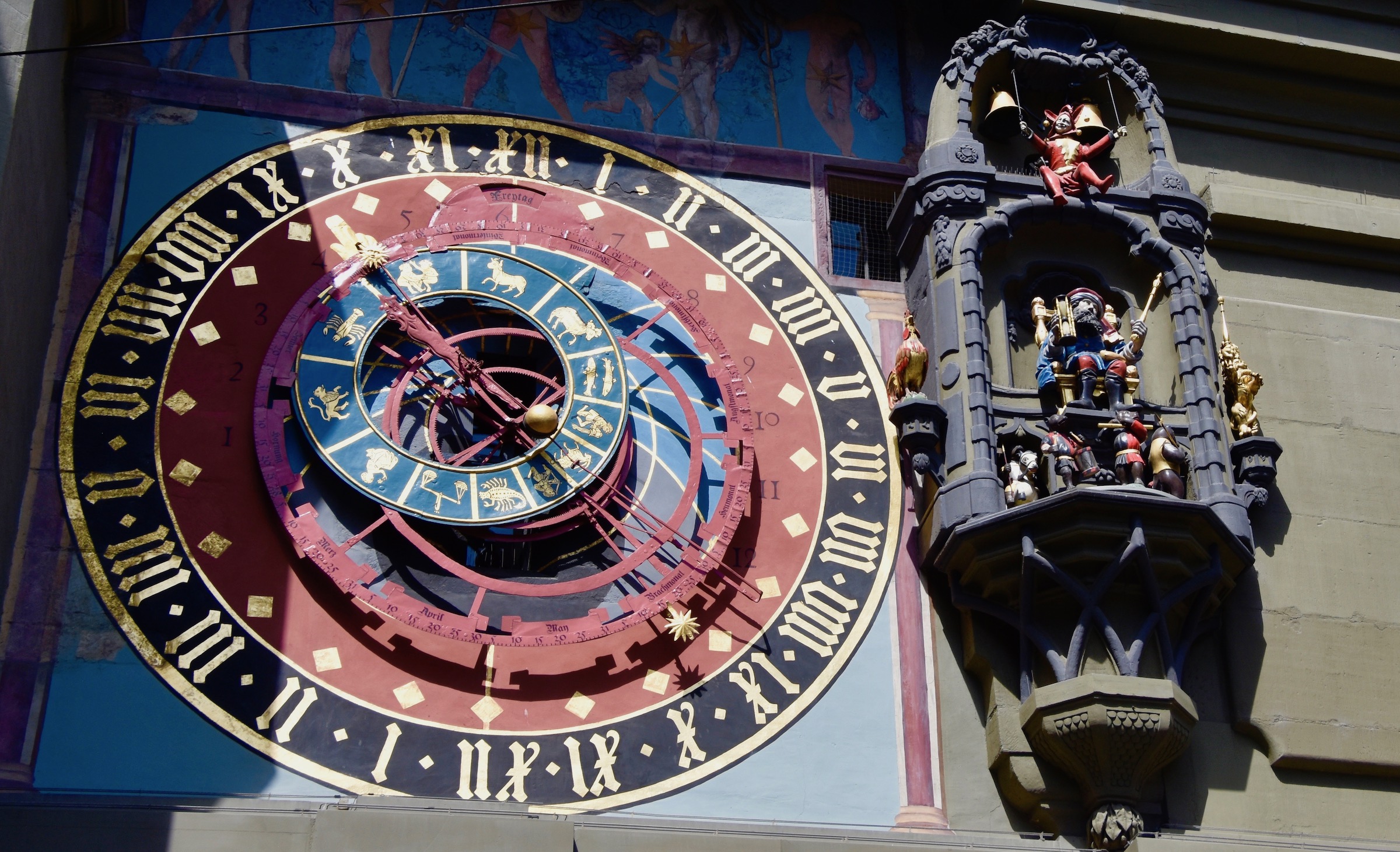
I was going to take a video of the performance that lasts only a minute or so, but then decided I wanted to actually see the thing for myself so put the camera away. There are tons of videos on You Tube that will give you an idea of what to expect. I particularly like the black and white one from a 1932 Pathé production. However, to be honest, the whole thing is a bit underwhelming.
What is not underwhelming is the Kramgasse, the street that runs from the Zytglogge through the heart of the medieval city. It is lined on both sides with the arcades that have made Bern into the one of the largest covered shopping promenades in the world. All told there are over six kilometres of them in the city.
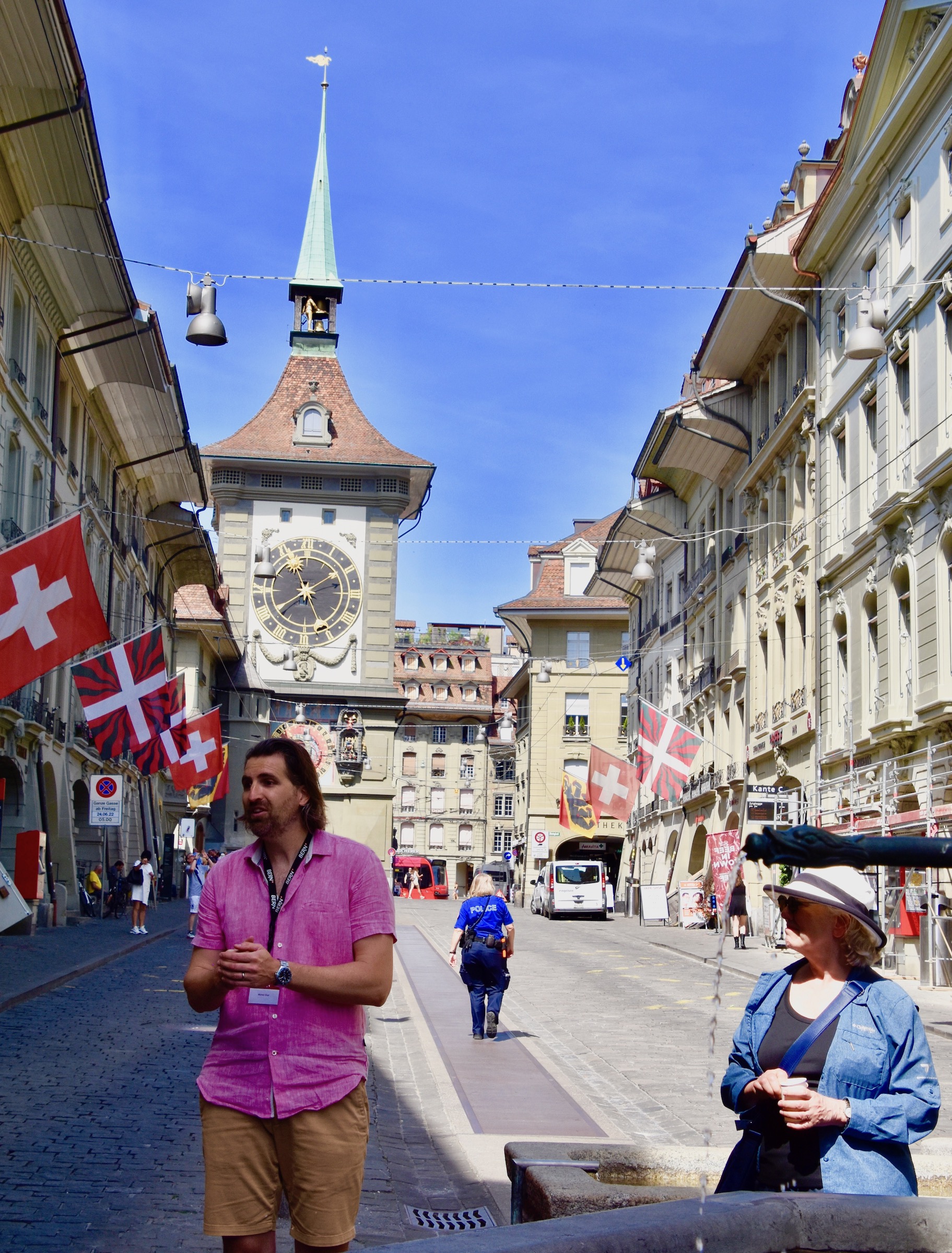
The Kramgasse also features more of the famous Bern fountains including the Zähringerbrunnen which was built in 1535 as a tribute to the man who founded the city in 1191. That’s a bear in armour, not a man, holding a flag and shield with the Zahbringen emblem of a lion.
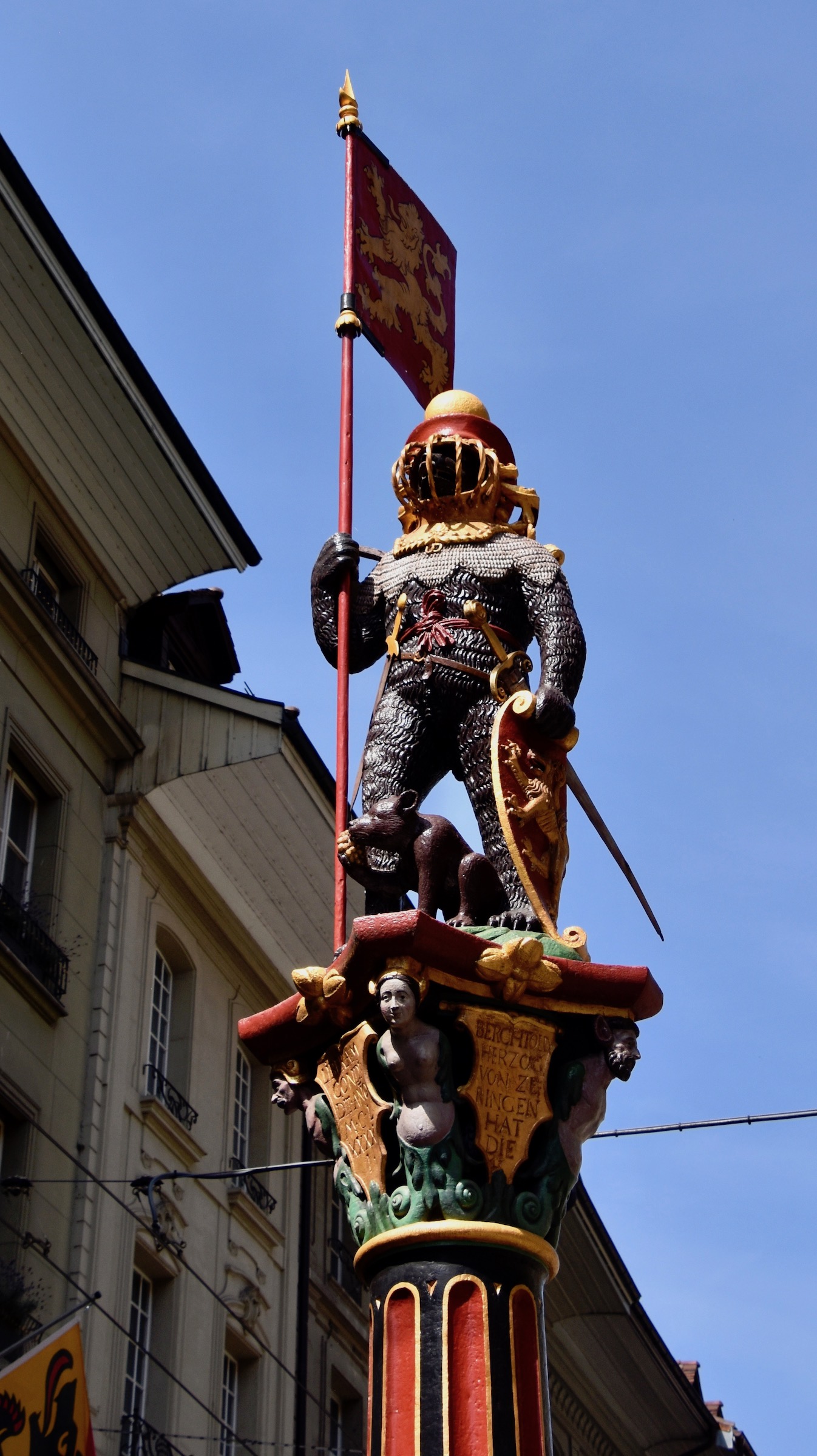
Further down the Kramgasse is the Simsonbrunnen, another Hans Gieng fountain; this one depicting the Biblical story of Samson killing a lion with his bare hands. It was created in 1544. Note the famed ‘jawbone of an ass’ that Samson used to slay a 1,000 Philistines.
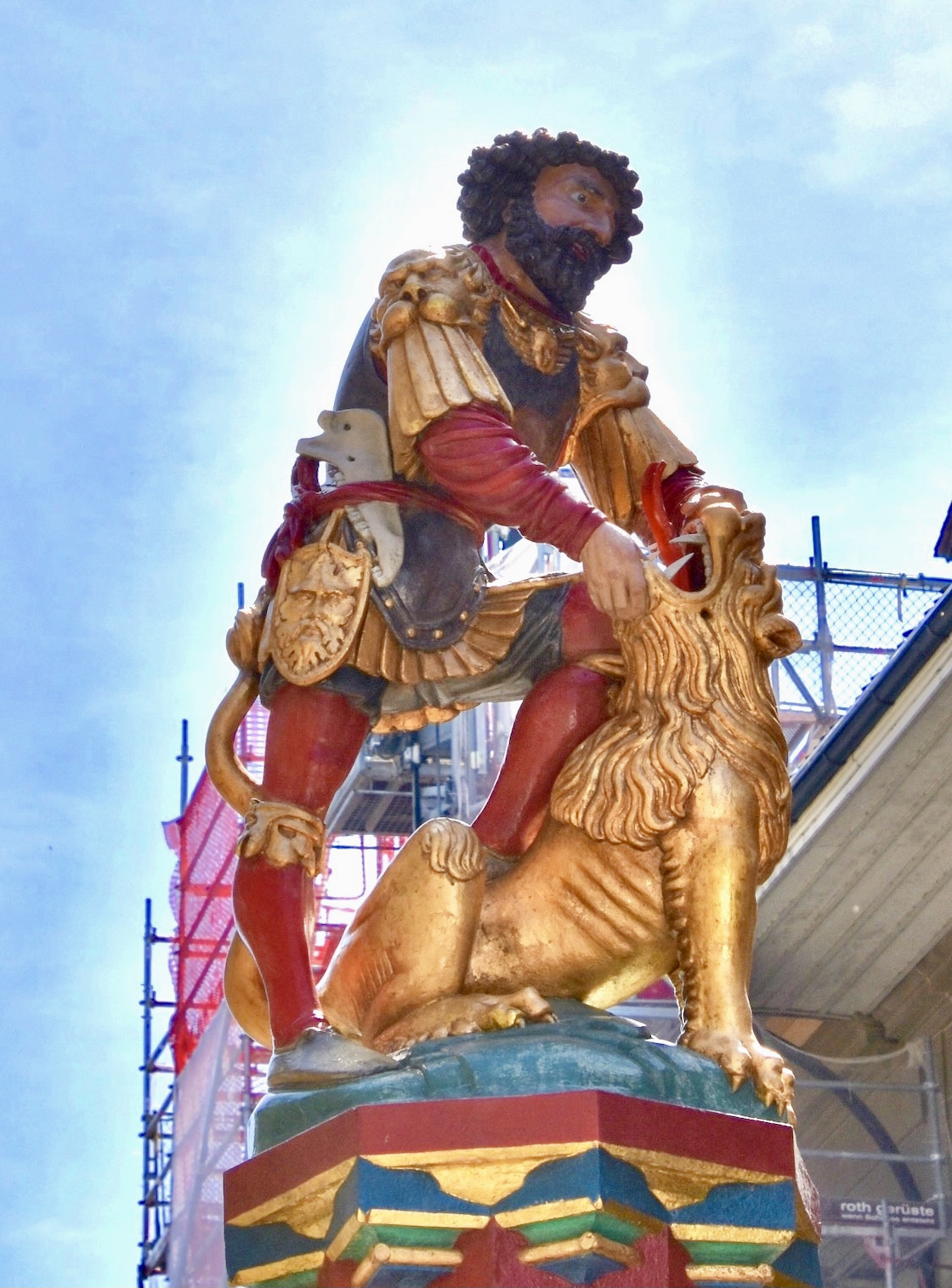
The Kramgasse boasts a more recent famous resident than Samson. Albert Einstein lived here from 1903 to 1905 and came up with a modest idea that changed the world forever. Within the walls of this house the Theory of Relativity first saw the light of day. He definitely deserves a fountain for that.
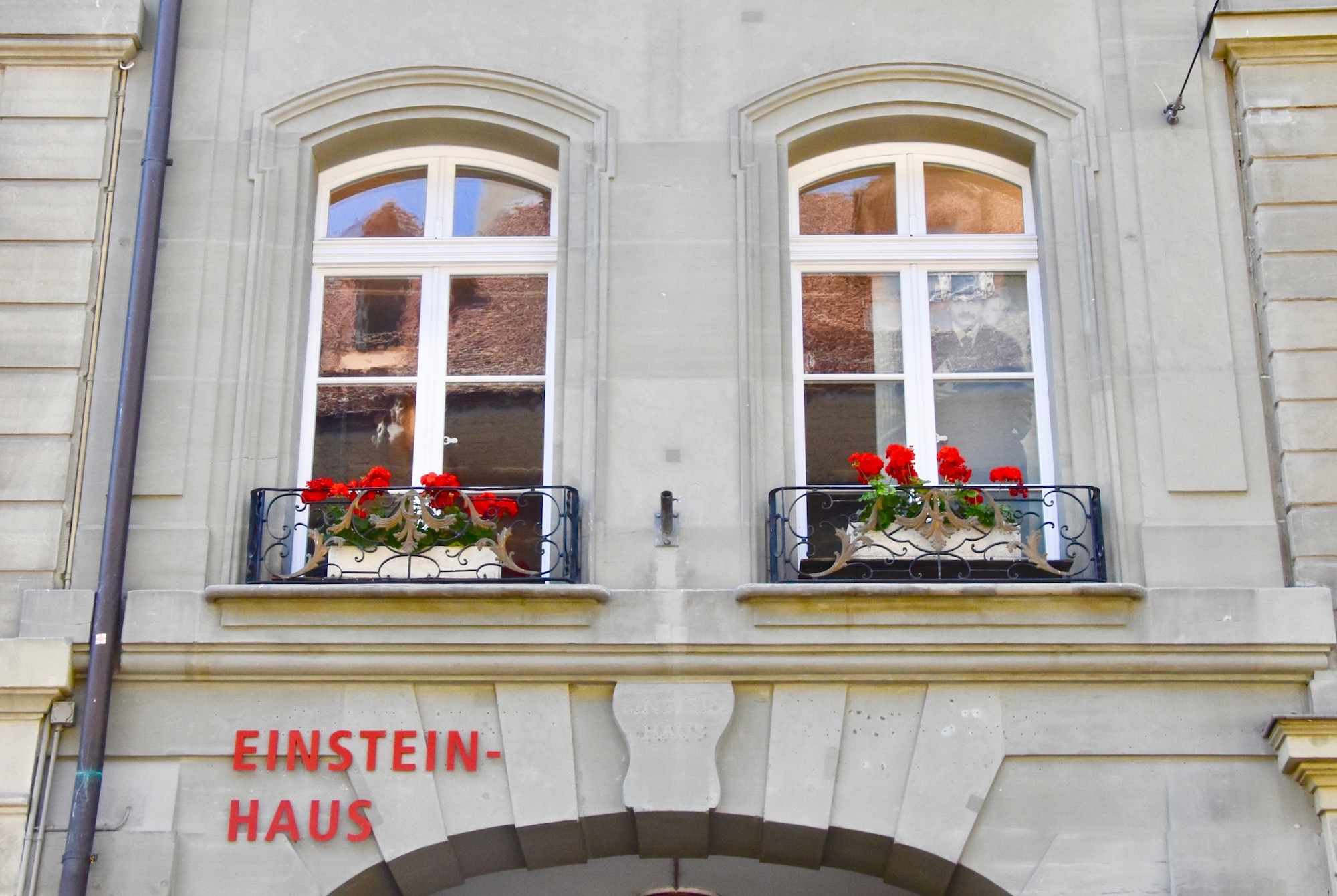
Turning right off the Kramgasse we next come to Munsterplatz where the cathedral of Bern comes into view. Started in 1421 and not officially completed until 1893 which must be some kind of record for a Gothic edifice, it boasts the tallest spire in Switzerland.
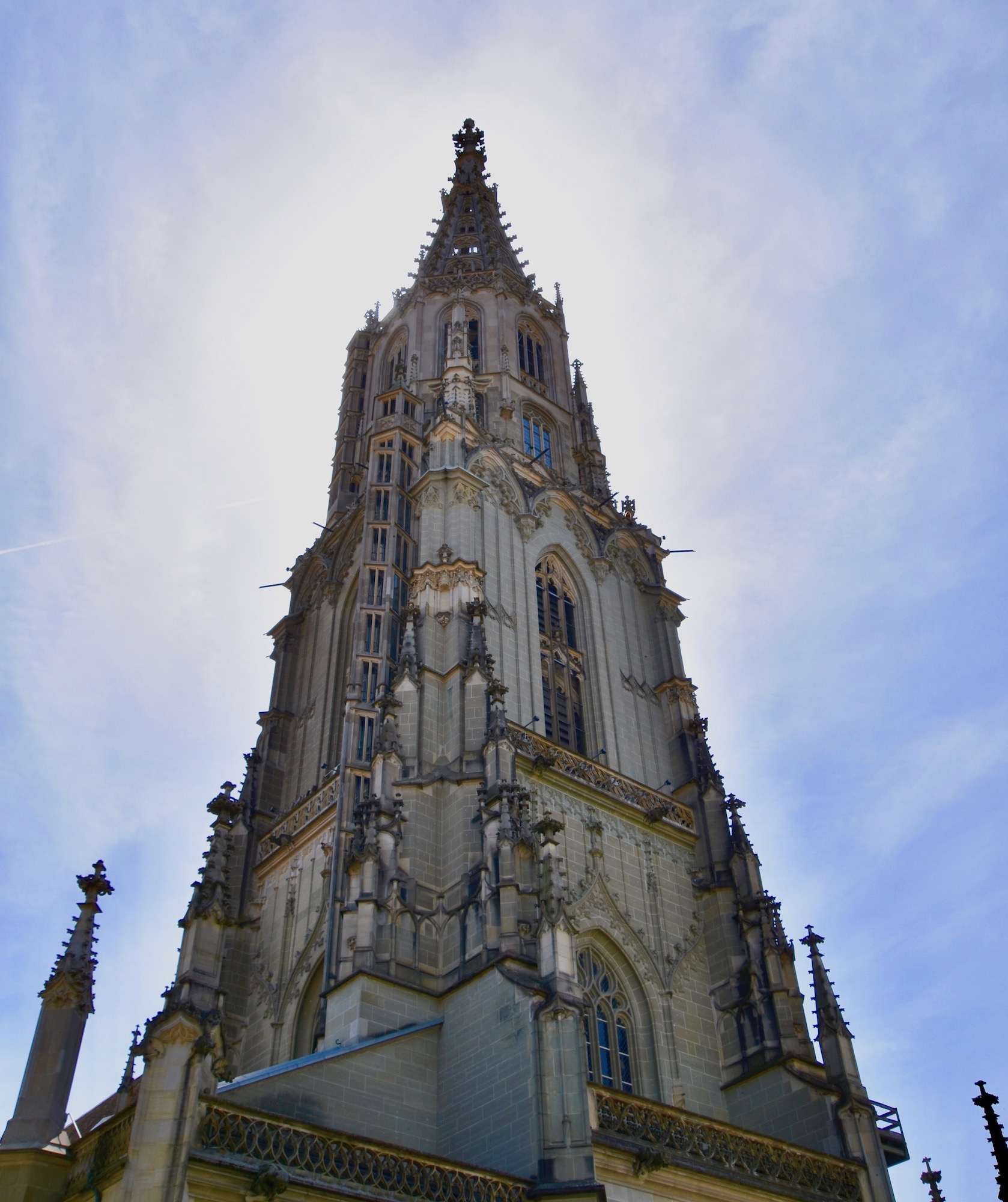
It also has some really cool gargoyles including this one that is Bern’s version of Quasimodo, the famed Notre Dame bell ringer. This poor creature is the epitome of grief and you can’t help but feel sorry for him.
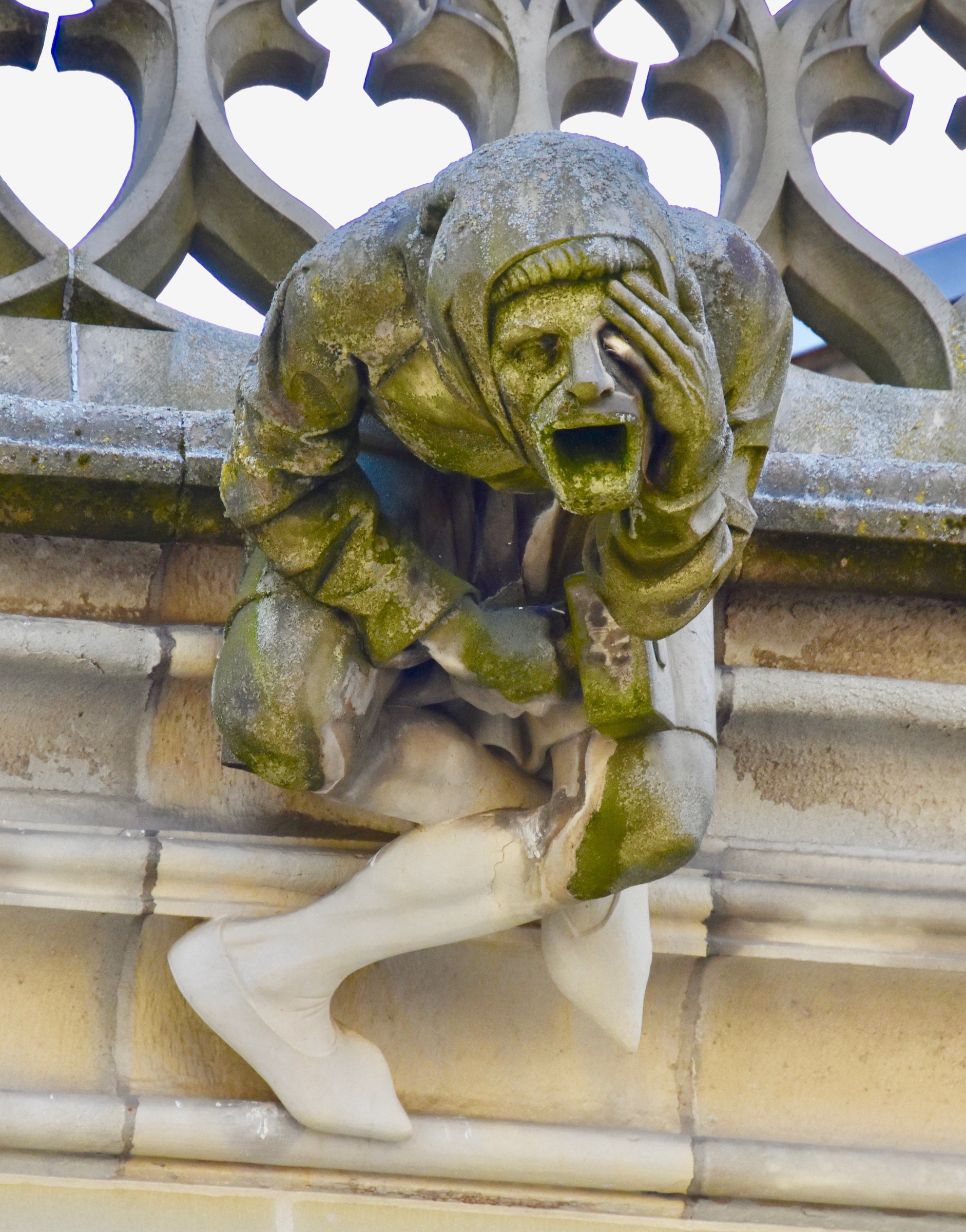
Another feature of the Bern cathedral that is compelling is this depiction of Judgment Day over the central portal. Created around 1500 by Westphalian sculptor Erhart Küng, it contains 294 individual sculptures which collectively make this a late medieval masterpiece. Any person walking under it to enter the church would be under no illusions as to what would happen to them if they fell into the sinners category on the Day of Judgment.
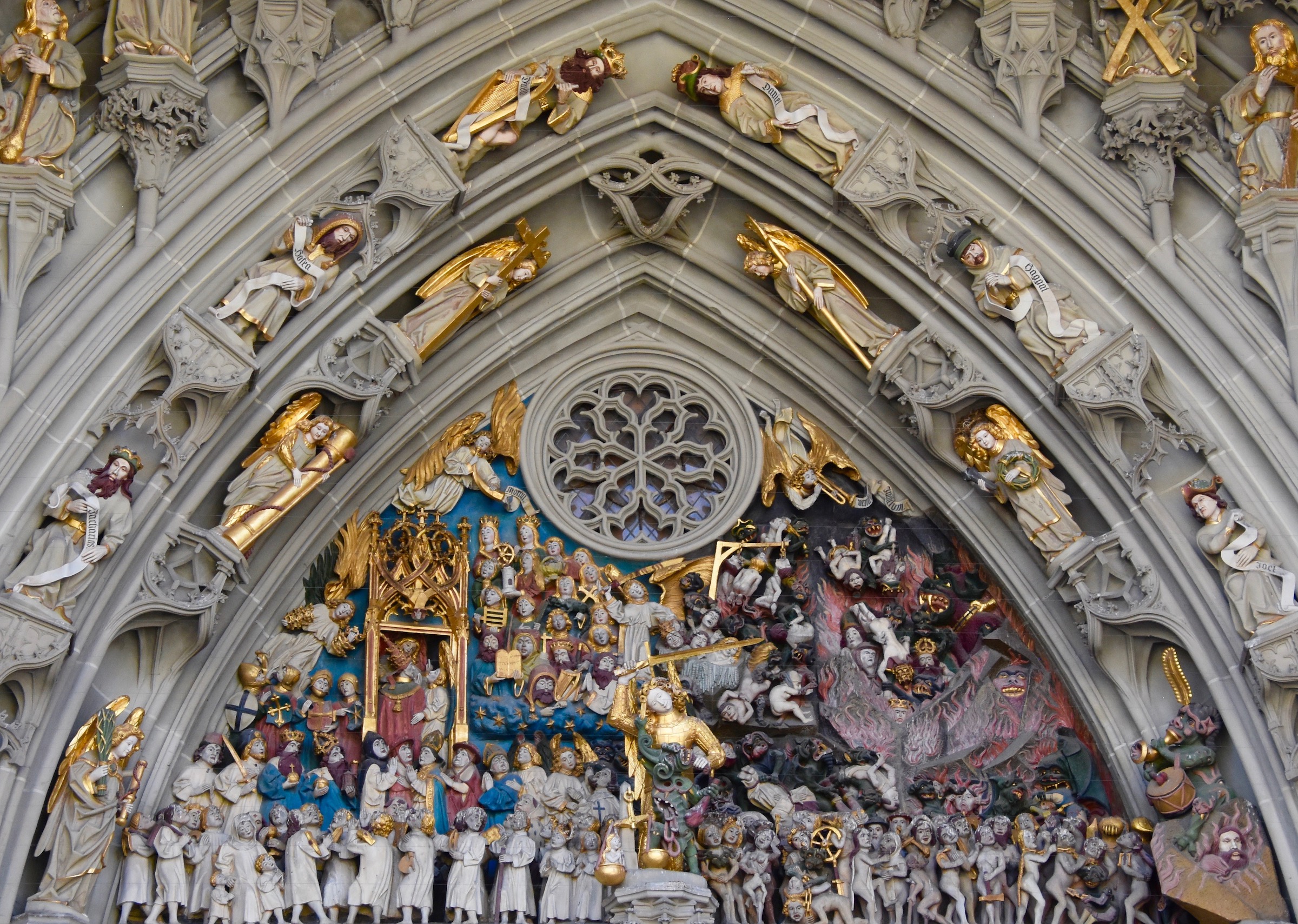
In case you needed any reminder about what would get you into the sinners category you could consult the Ten Commandments as held by Moses in nearby Mosesbrunnen. Built in 1544, it has rays of light protruding from his head rather than the more customary horns such as are depicted in Michelangelo’s sculpture in San Pietro in Vincoli, Rome.
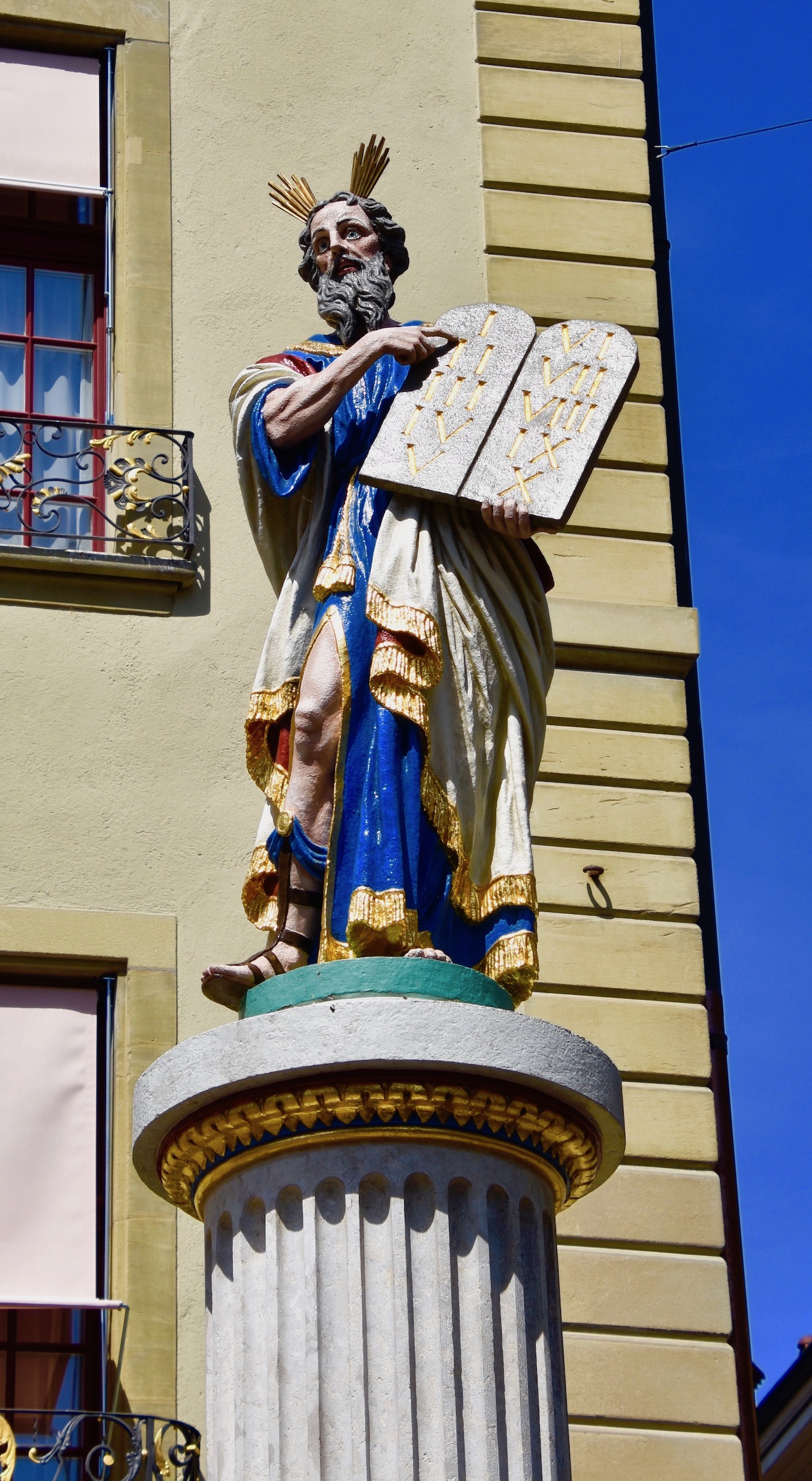
I would love to have had the time to climb the 344 steps to the upper viewing platform where the views are said to be among the best in Switzerland, but that is a good reason to return to Bern for a more thorough visit in the future.
Still the consolation views from the Munsterplattform that overlook the lower city area known as Matte and the Aare River are pretty nice.
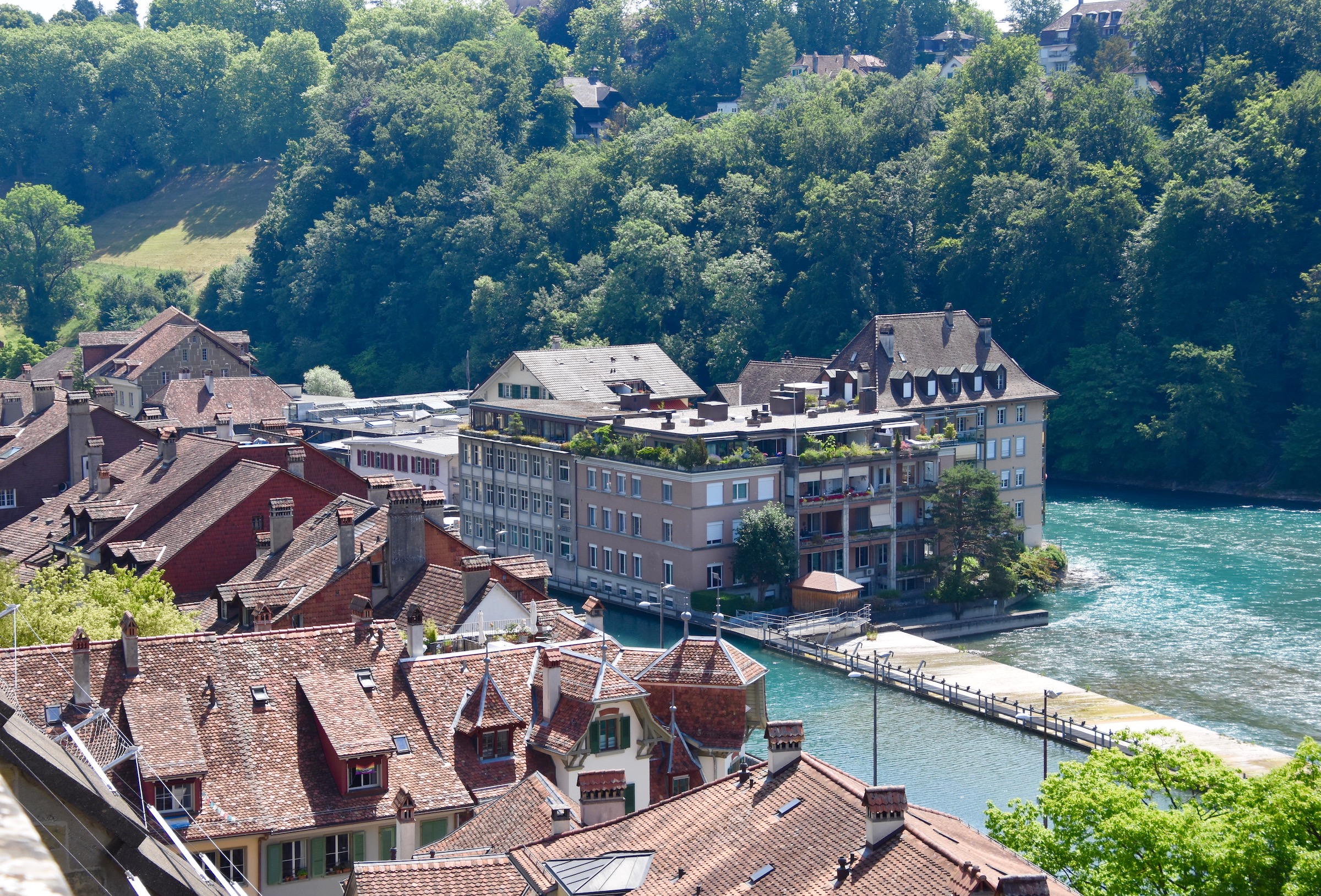
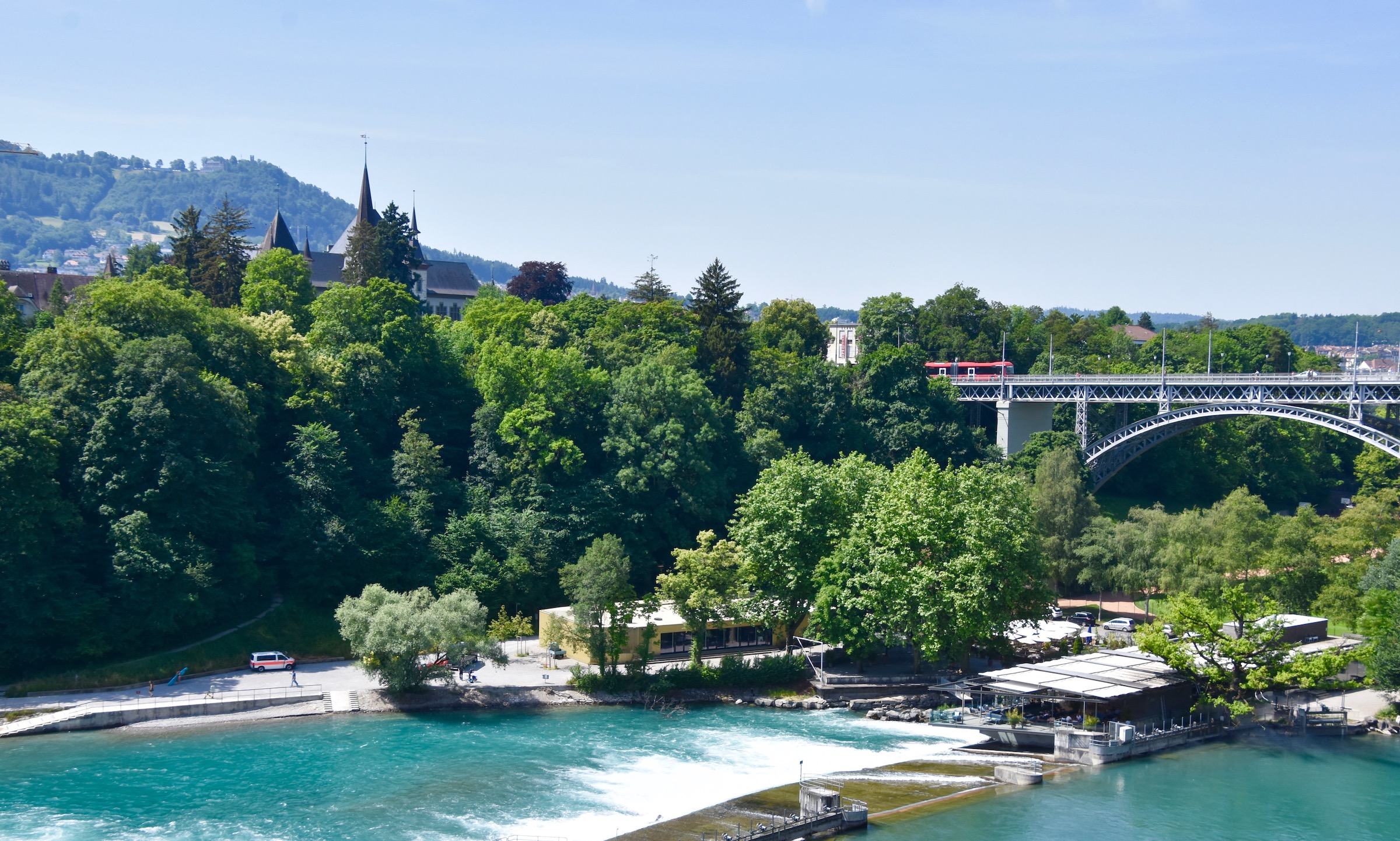
The Matte district not only contains the oldest houses in the city, but also a number of communal gardens which are as well kept as you would expect from the burgers of Bern.
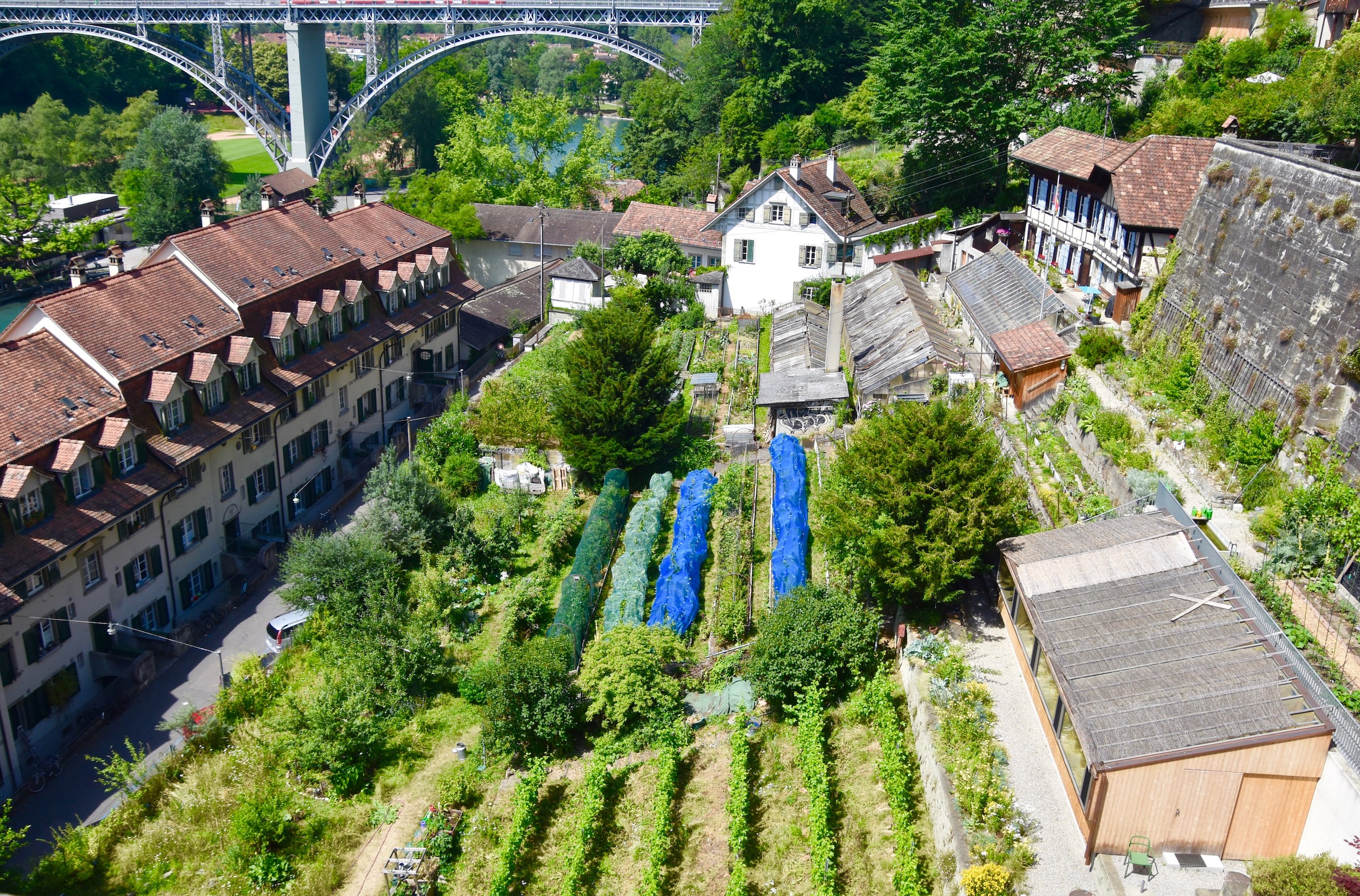
The Munsterplattform is also a good spot from which to appreciate the architecture of the upper city as well.
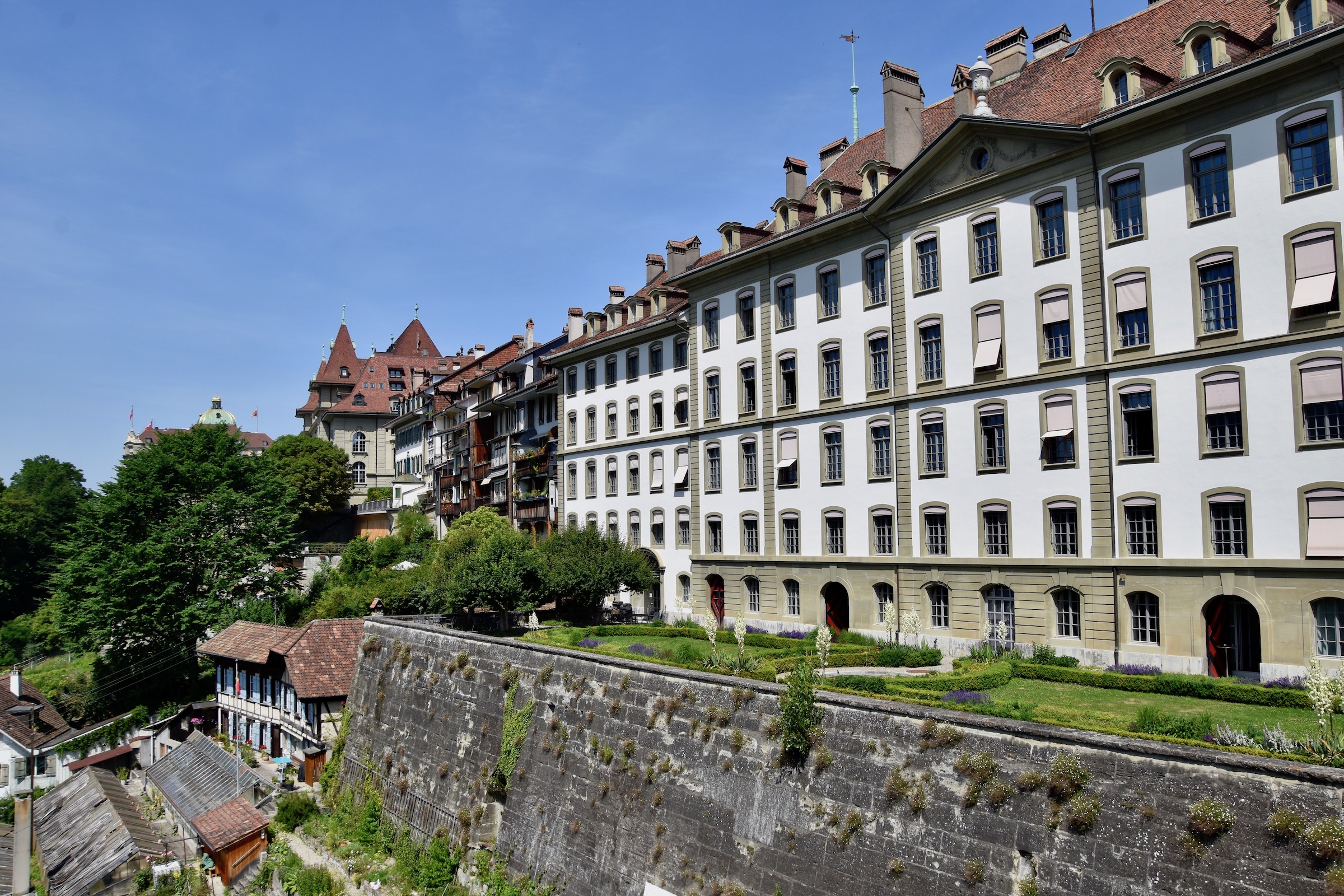
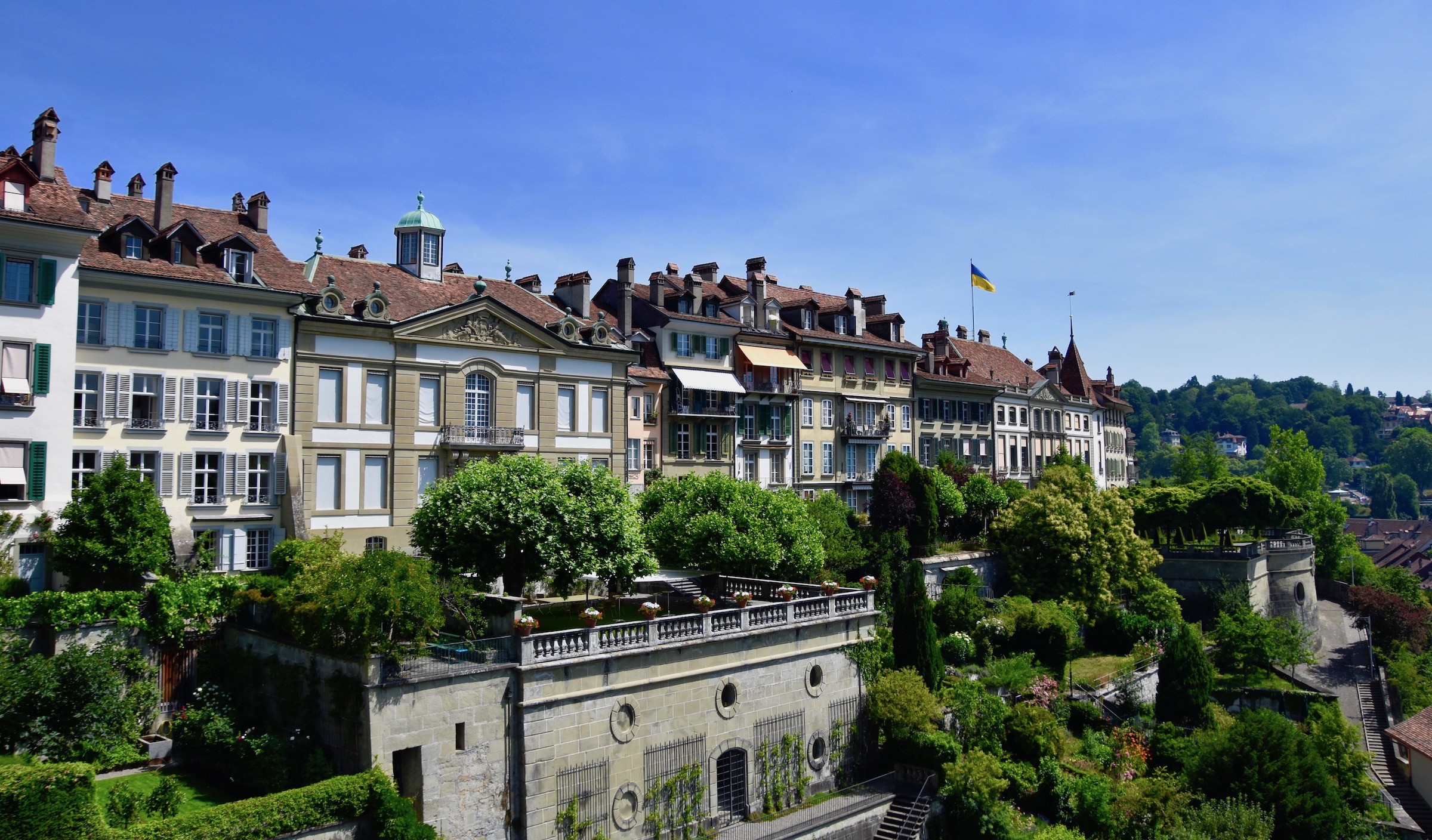
Turning back toward the centre of the medieval city we pass through a number of arcades which despite their antiquity have been thoroughly modernized.
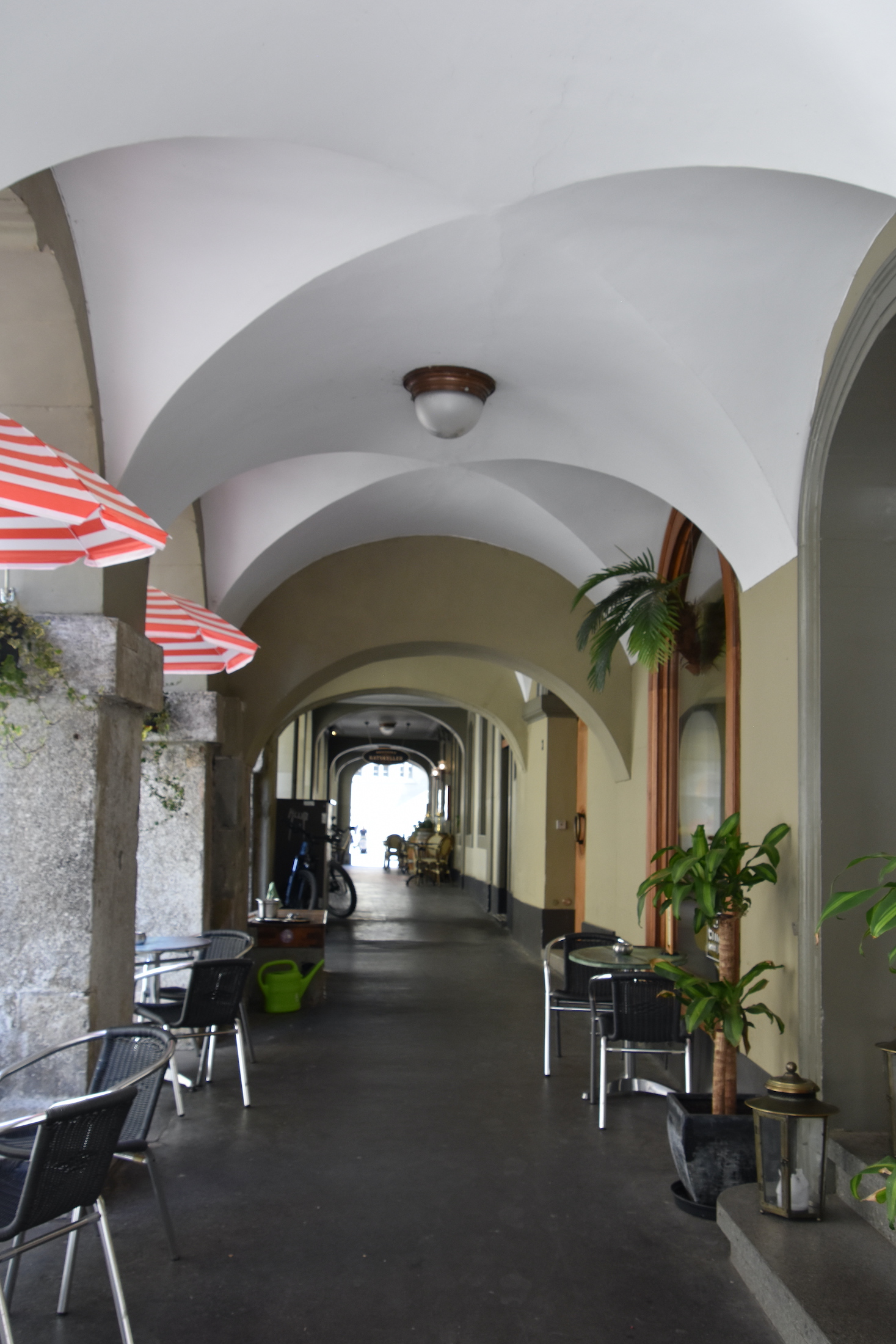
The next stop is before the Bern Rathaus which is over 600 years old and hosts both the Bern city and Bern Canton governments. In 1946 Winston Churchill gave a speech from the balustrade to thousands of cheering Bernese.
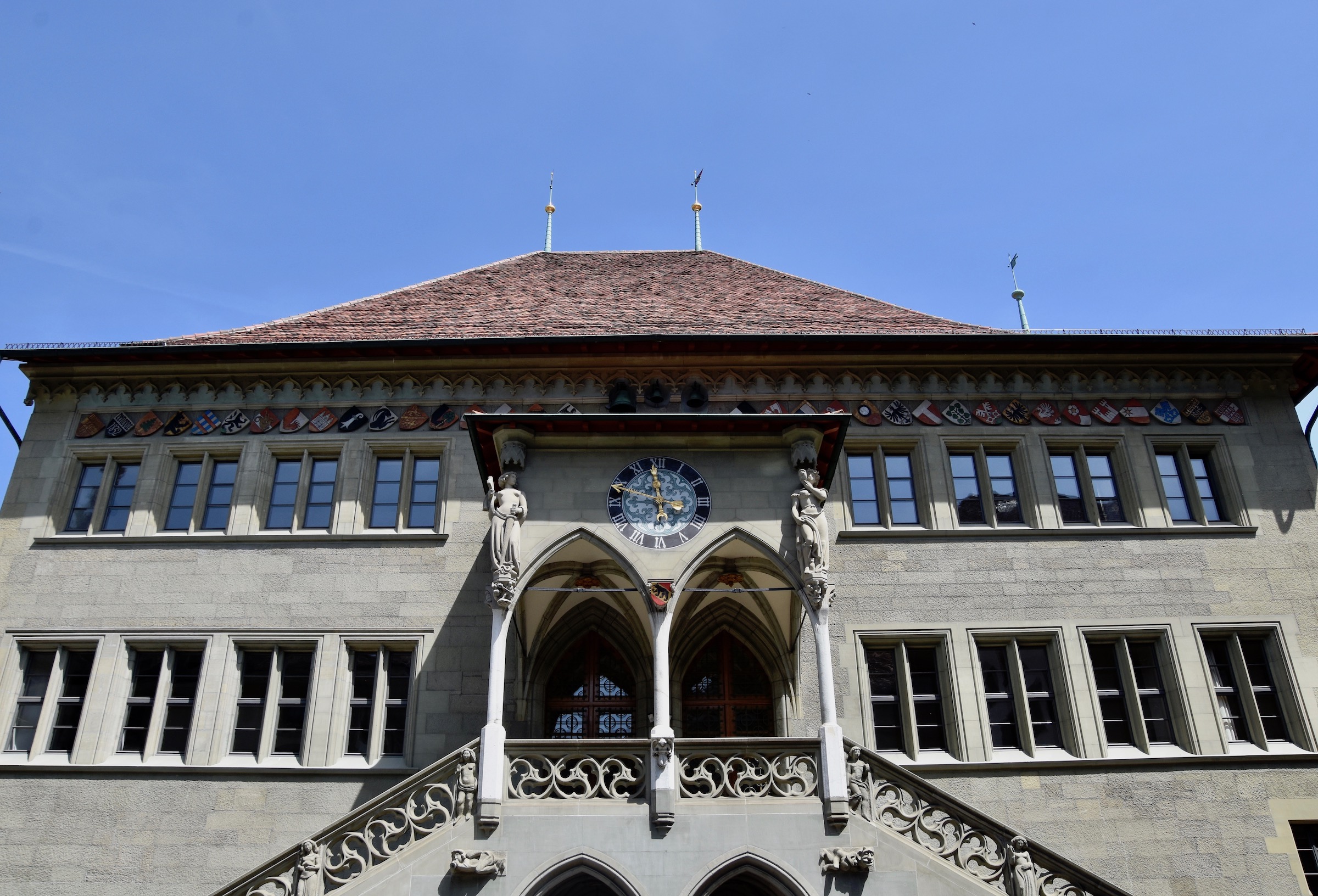
Our tour with Michael was now winding down with one final fountain, the vennerbrunnen or knight fountain.
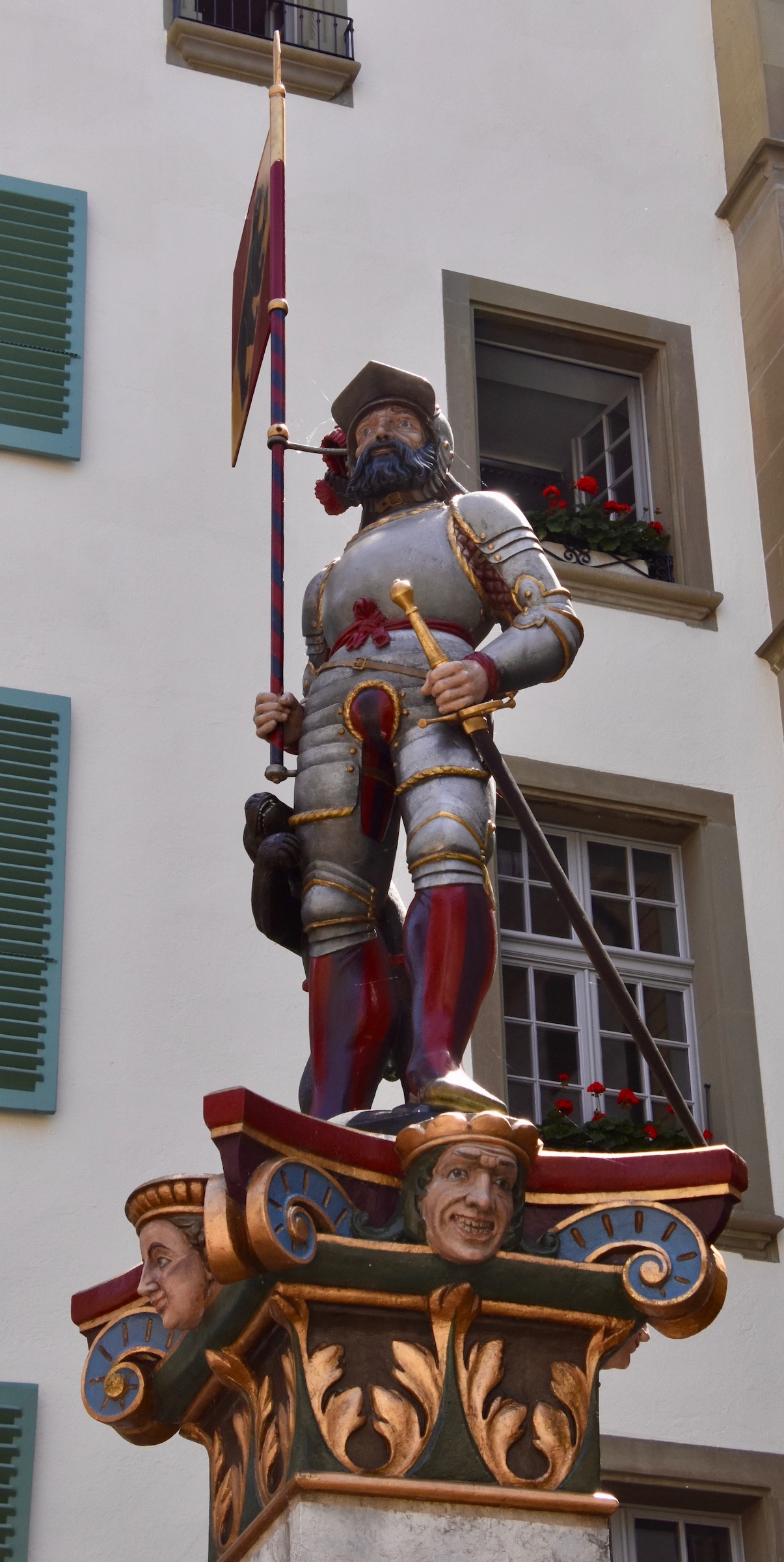
We said goodbye to Michael and were now free to explore on our own for a few hours before catching the train back to Lucerne. There are two bridges over the Aare at the very end of the peninsula upon which old the old city is built. One goes directly from the highest point on one side to the highest on the other and the other crosses from the lowest point. Here is a photo of the lower bridge from the upper bridge. The water of the Aare is just as aqua coloured in Bern as in Interlaken
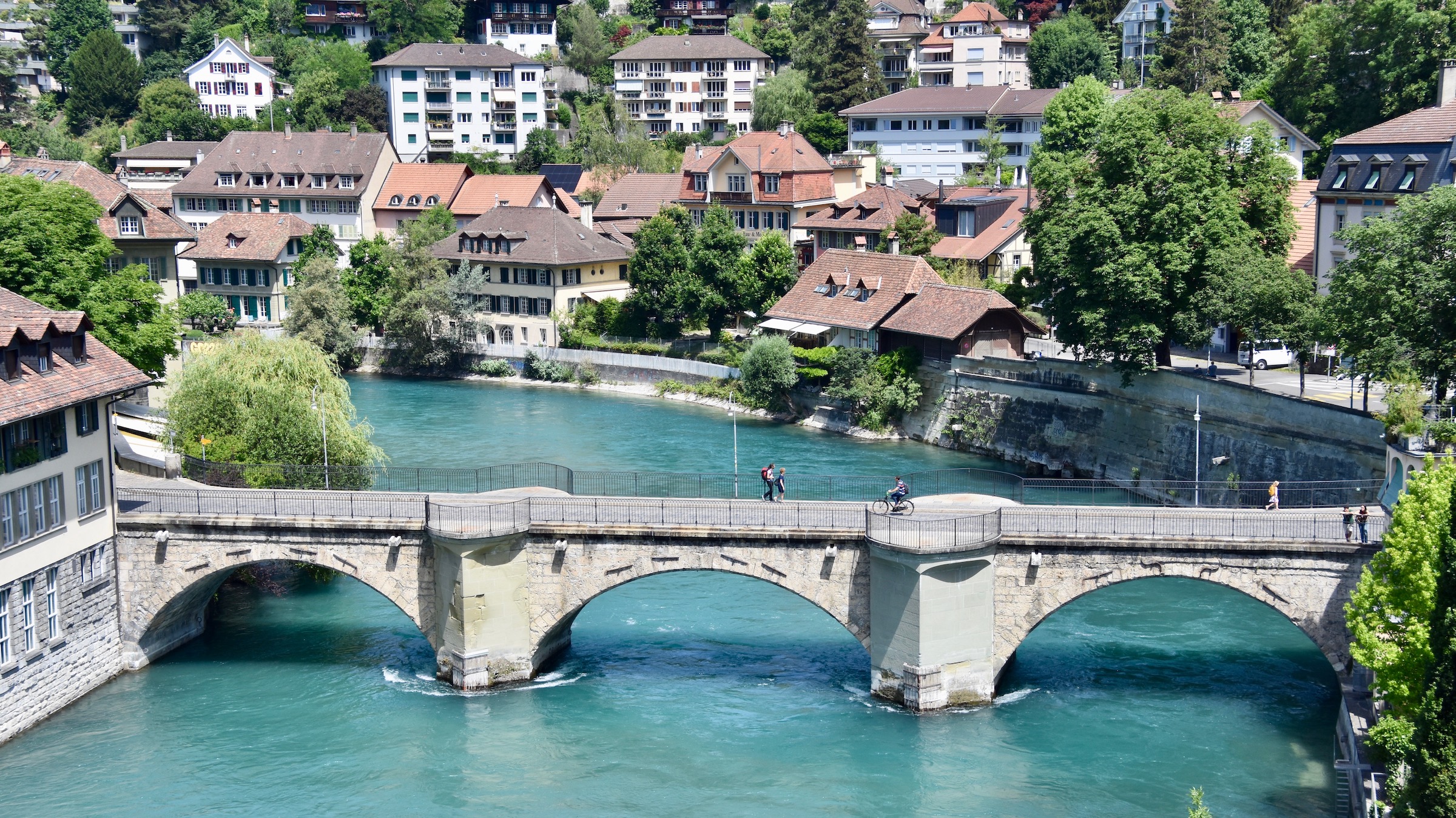
On the other side of the high bridge we found what was once the bärengraben which until 2009 was a place where bears had been kept since the 1500’s. Now the bears are housed in a much larger facility nearby. Also on the other side of the bridge is the very large Altes Tramdepot Brauerei Restaurant which specializes in craft beers and pretzels. I’d never had a pretzel sandwich before and won’t be waiting a lifetime before I try another one. These things are seriously delicious and the perfect accompaniment to a cold brew.
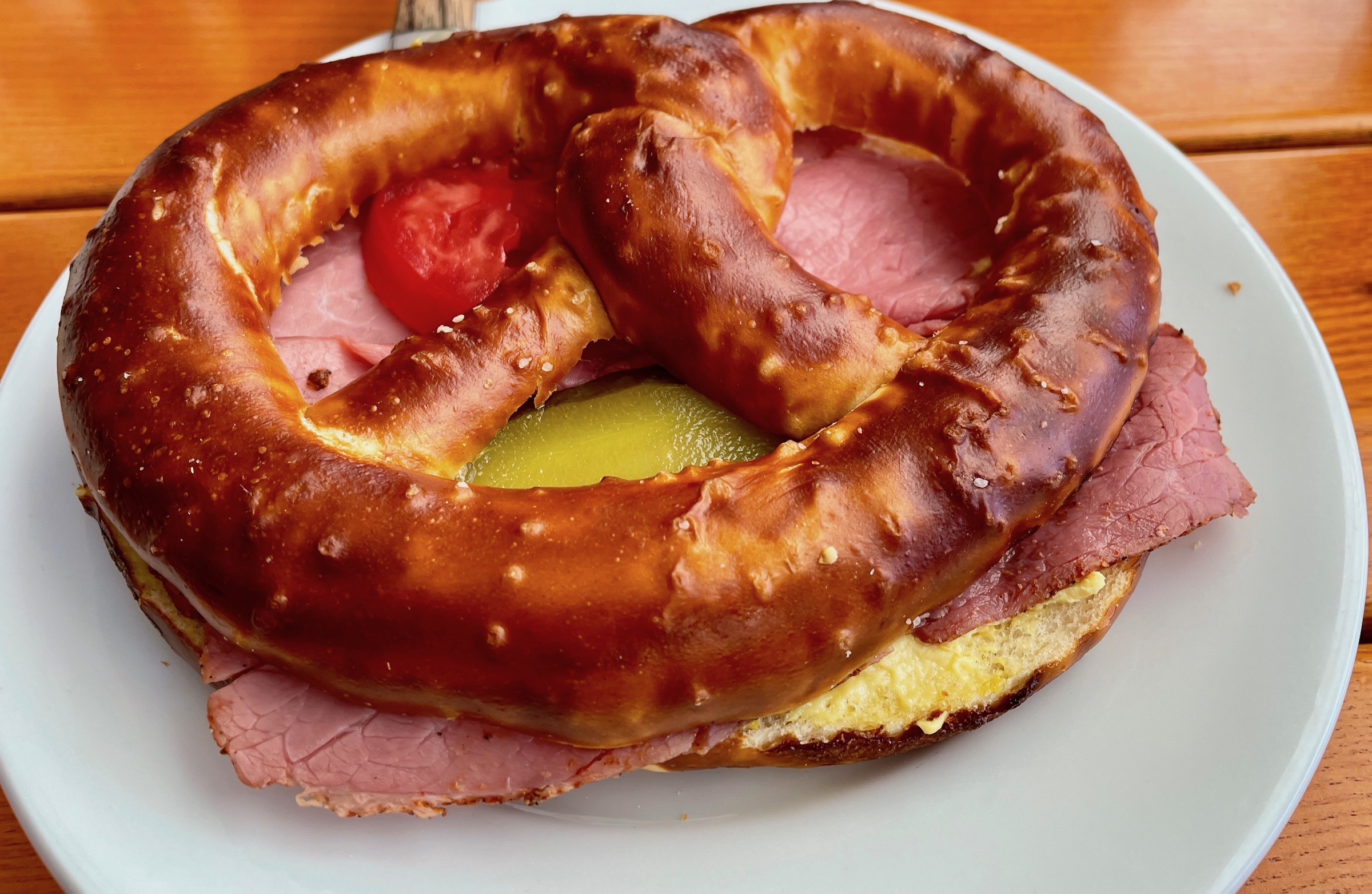
Swiss cities are notable for their gardens and floral displays and Bern is no exception. As we walked toward the lower bridge to return to old Bern I noticed this beautiful and fragrant display of roses.
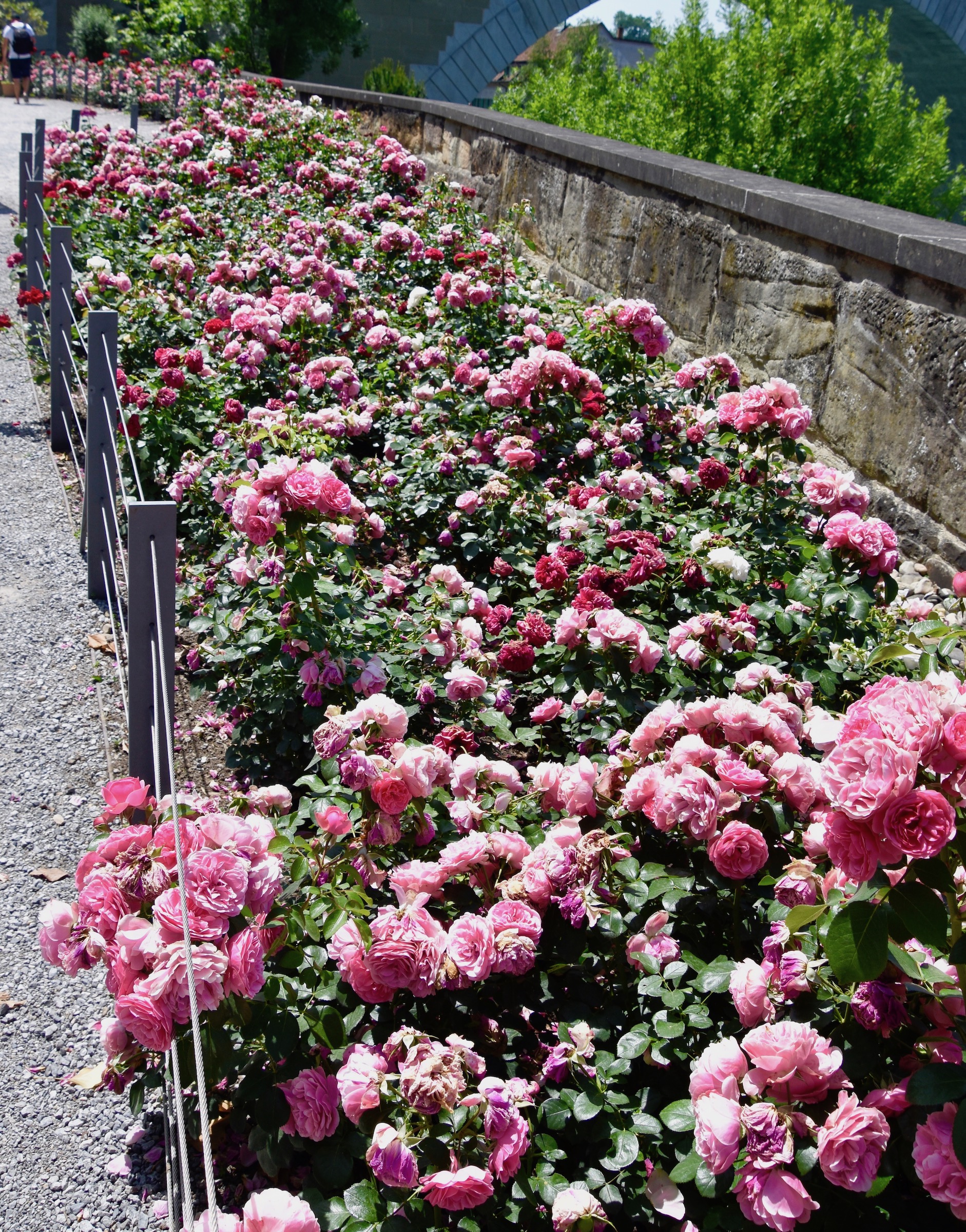
More great views of Bern are on display from the lower bridge, including a great look at the cathedral.
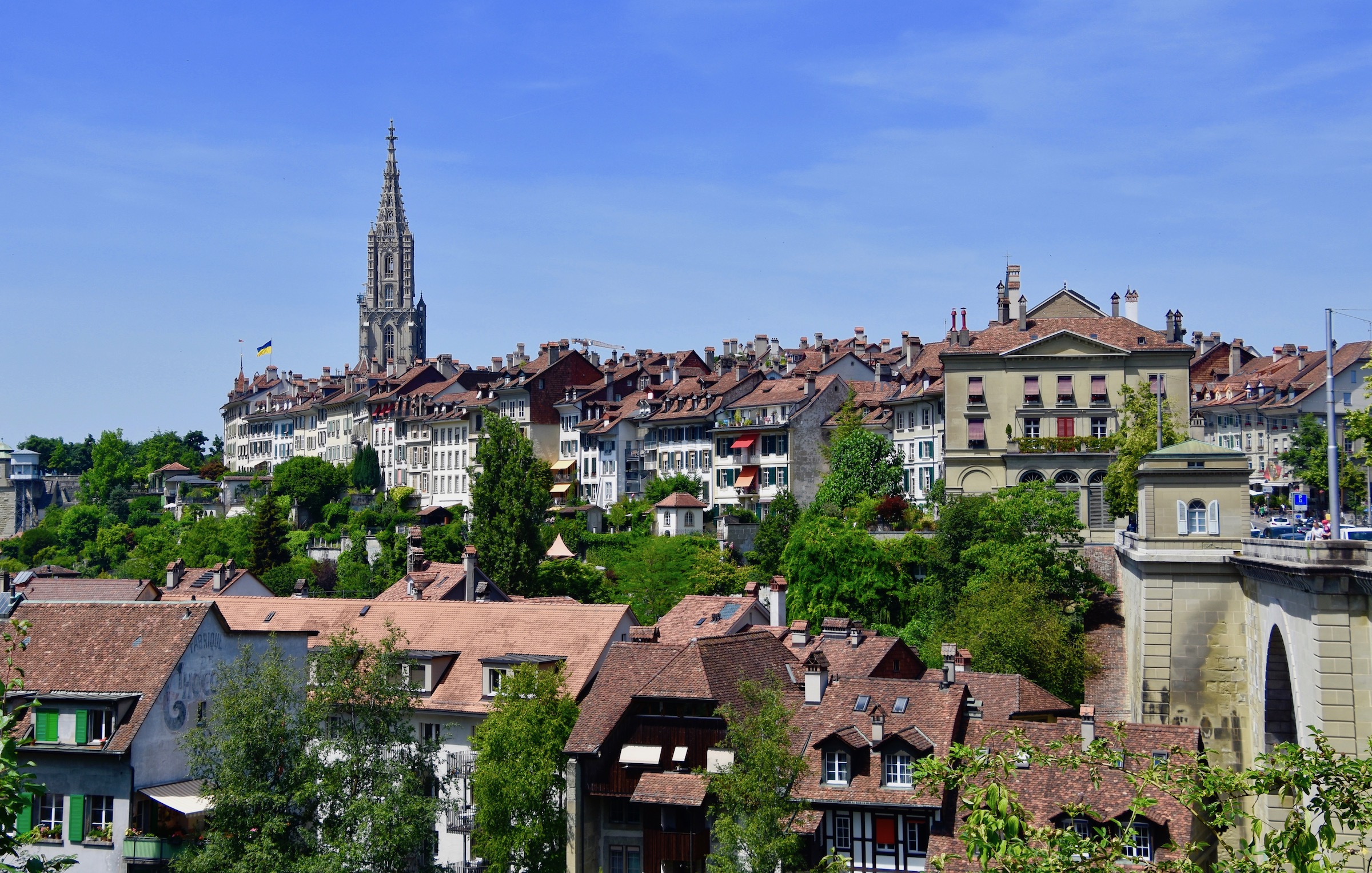
We knew there were a few more fountains that we had not seen and made it a point to find some of them as we made our way back to the station. This is the Gerechtigkeitsbrunnen or Justice Fountain which is considered Hans Gieng’s finest accomplishment. The traditionally blindfolded figure stands atop the heads of a pope, emperor, king and sultan indicating the claim, if not always true, that no one is above the law. It is a reproduction of the original which was partially destroyed by Jurassic separatists (yes there are such things) in 1986 who pulled it down with a block and tackle and is still in the process of restoration. Why people think their causes can be advanced by destroying works of art that have been admired and beloved for centuries is beyond my understanding.
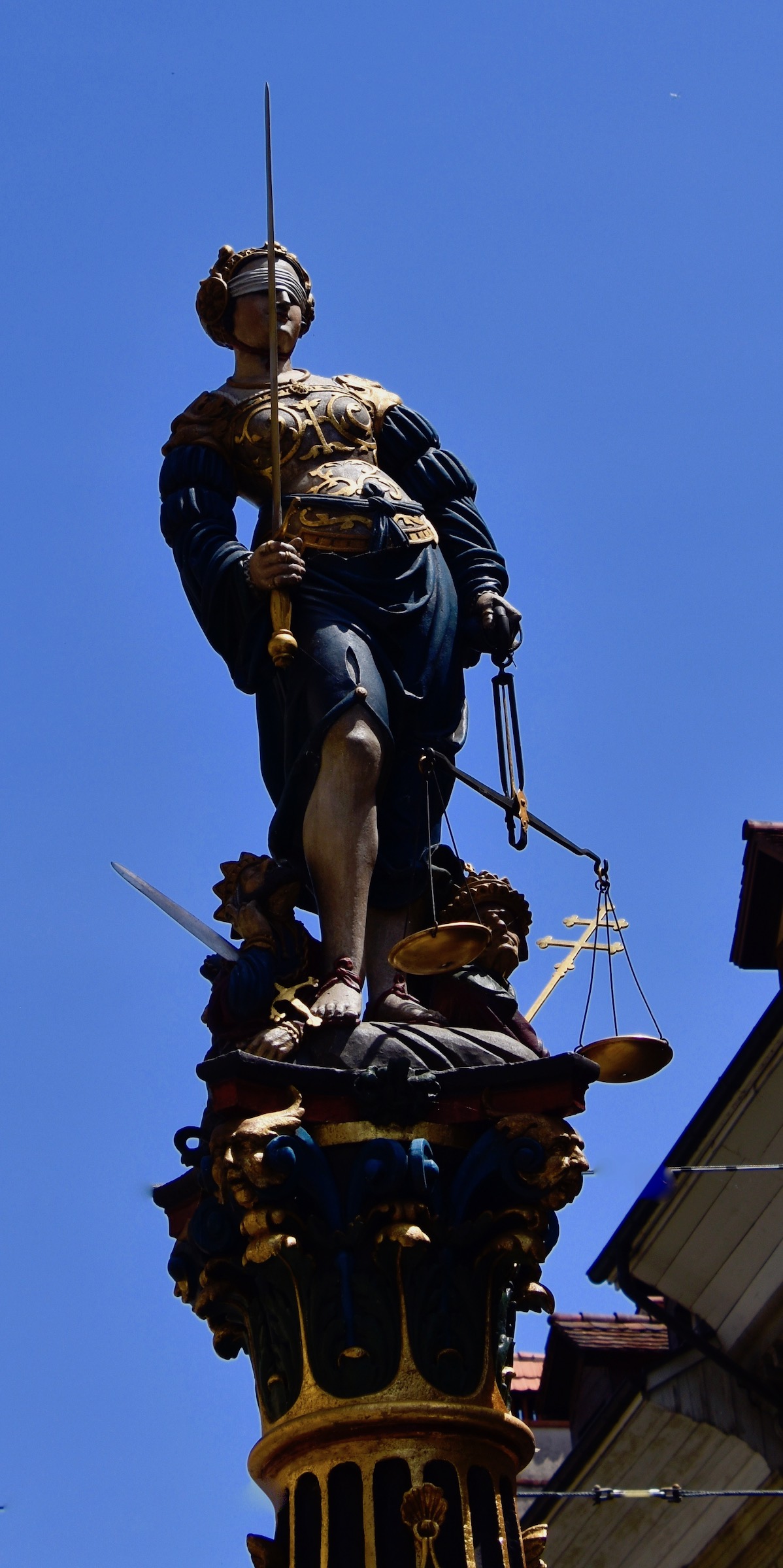
The final fountain we found in Bern was easily the most disturbing and reminded me of Goya’s famous work depicting Saturn devouring his son. It is the Kindlifresser or literally Child Eater fountain and it is horrific in its depiction of an ogre eating a child while three others are slated for a similar fate. It is another Hans Gieng work, but nobody knows for sure why it was commissioned or what it is meant to represent. If the idea was to bring potential brats to gaze upon it and fear what might happen to them then it surely must have worked. As an image that would cause nightmares and fears in young children this one is hard to beat.
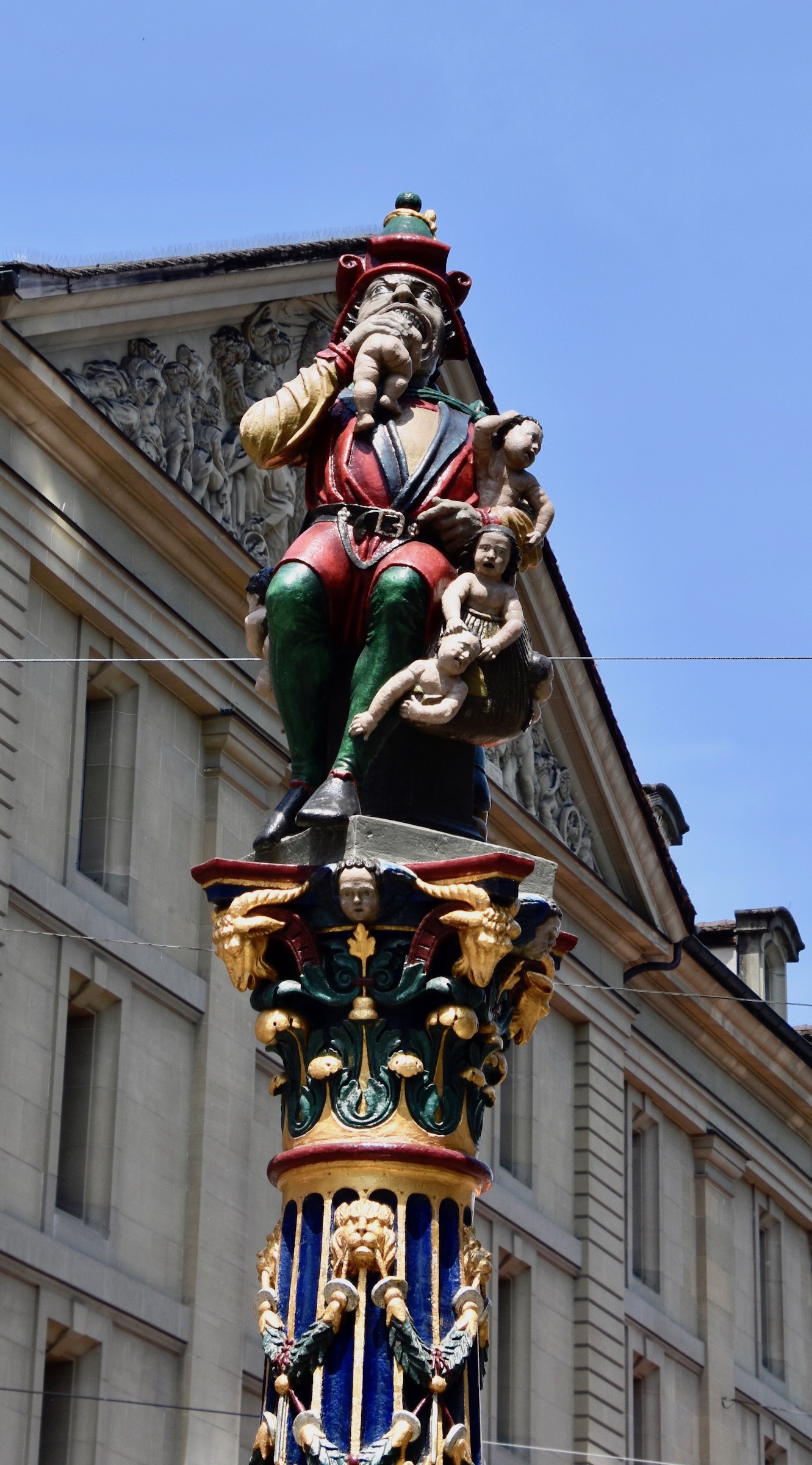
I end this post and in fact the entire Switzerland tour with one last photograph. This is a golden foot at the entrance to the Bern opera house. Don’t ask me why or when it was created as there is virtually no information about it on the internet. Just call it another Swiss enigma.
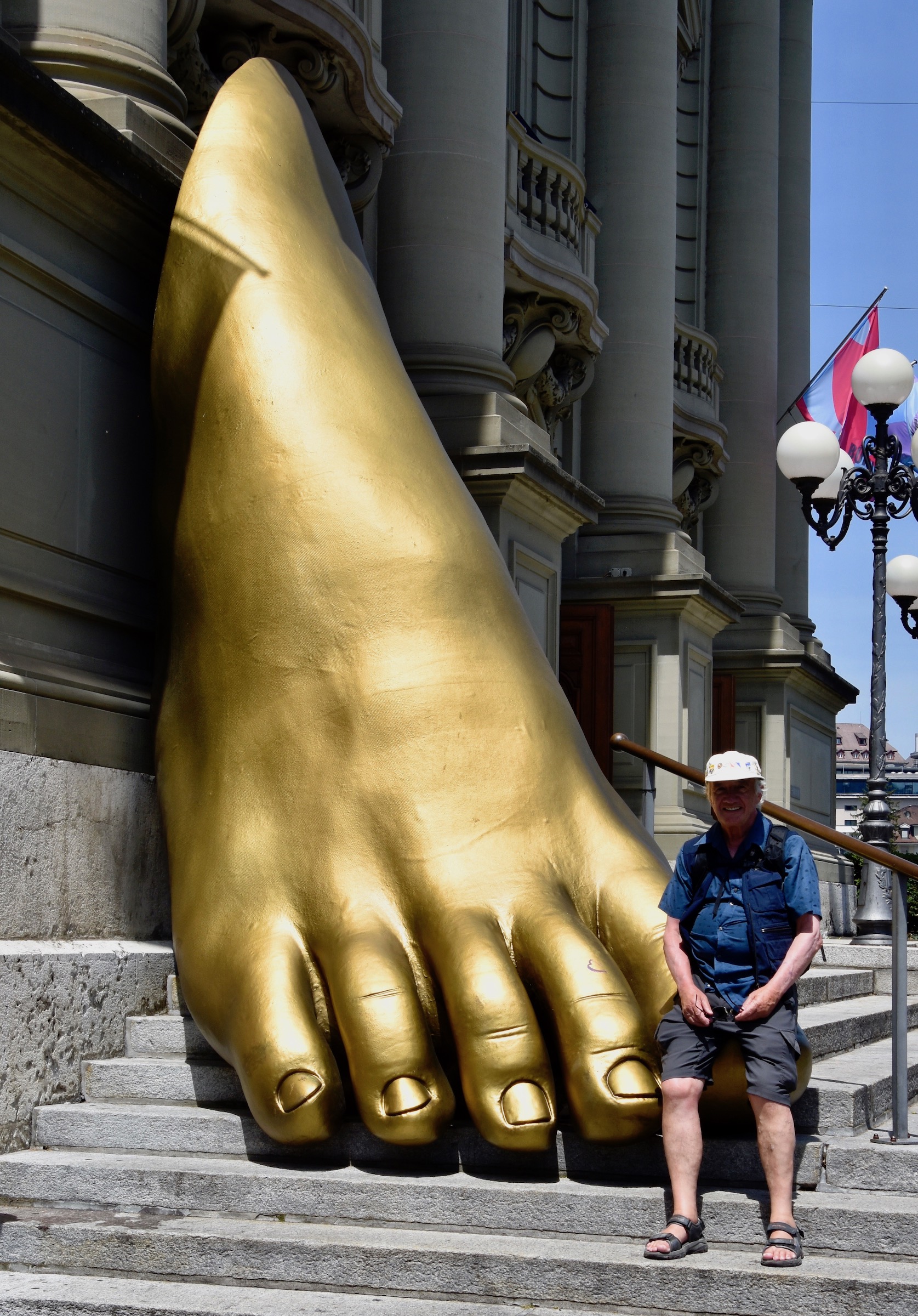
We said goodbye to Victor and our fellow companions the next morning as we all went our separate ways from Lucerne. However, it was with the knowledge that we would be joining Victor on another exciting adventure in April 2023 on a tour that Victor and I designed together. In only a few weeks time Alison and I will head to Istanbul for the start of the Via Egnatia tour through European Turkey and northern Greece and I can’t wait. I hope we’ll see you there.

